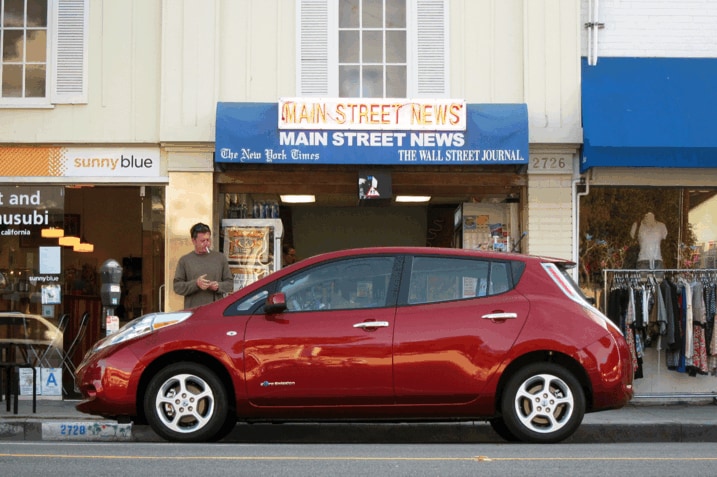2011 Nissan Leaf: What's It Like to Live With?
Read the latest updates in our long-term road test of the 2011 Nissan Leaf SL as our editors live with this car for a year.
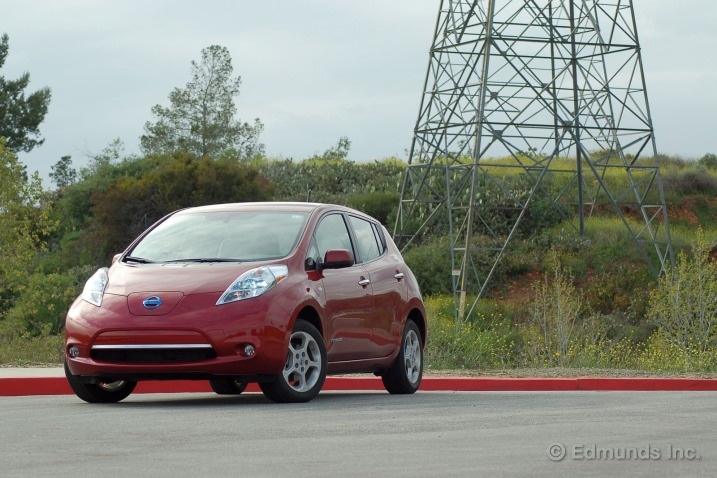
What do you want to know about?
- Introduction
- What Range Anxiety?
- Serious Commuter Car?
- Part Car, Part Golf Cart, Part iMac
- Shifter or Mouse?
- Charge Time is the Challenge
- Clock Confusion
- A Simple Interface for a Complex Car
- More Engine Than Engine
- Running On Empty (Nearly)
- Cruising in "Eco" Mode
- Suspension Walkaround
- Smart Planning for Smart Energy
- Community Weekend
- Counting Up The Cost
- Campgrounds Cure Range Anxiety
- Not Made for Emergencies
- Potential Start Button Failure
- How To Get To Fontana
- Oh, Very Funny
- Christmas in April
- Happy Tree Friends
- Prius-Like Upholstery?
- A Natural
- Also a Top Safety Pick
- I Win
- Track Tested Long-Term Road Test
- Driving It To The Bitter End
- Average Use Patterns
- Could Use Some Flippers
- April "Fuel" Economy Update
- The Bitter End — Real-World Edition
- Feels Good In Eco Mode
- A Regular Ass Whooping
- How Much Can The Trunk Hold?
- Nice Big Greenhouse
- The Sound of Silence
- 2011 Nissan Leaf 'Runs Out of Juice' During Top Gear Filming
- Grounded Spaceship
- Peering Through Porthole Windows
- Proton Sauce
- It's Gaining on Us!
- Outside Opinions
- Simplified Green Tech
- Does This Bother You?
- Sales Growing
- Pod
- Easier Being Green
- Gasoline Powered Everything
- Security Breach With Carwings?
- New Charging Options
- AAA to Offer Mobile Charging
- In its Habitat
- First Production EV to Climb Pikes Peak
- None Shall Pass
- First Time
- Spidey Sense
- We Let a Reader Drive
- It Sure is Weird
- Drinking It Up at The Office
- Reverse Chime
- Flip? Flop!
- High Tech, Low Tech
- Price Hike for 2012
- Miles to Recharge
- No Feel For Speed
- An Analysis of the 2012 Nissan Leaf Price Hike
- Cheaper to Park Than the Volt
- How About a Green Thumbs Up?
- Just a Clown Walking His Dog
- Score one for the Leaf
- B-Class F-Cell Sighting
- Range is Always a Concern
- June and July Fuel Economy Update
- Max Range Round Trip
- Waiting for a Tow (live)
- Round Trip Attempt Fail
- A Leaf of My Own
- Brother of Another Color
- Our Favorite Caption
- You Write the Caption
- The Spoiler Solar Panel
- Video Walkaround
- Recommended by Me
- How Leaf Drivers Exact Revenge
- Wrap-Up
Introduction
If ever there was a place suitable for an electric car, Edmunds headquarters in Santa Monica, California, is the place. In addition to its near continually congested streets, the climate here rarely dips below or above the Goldilocks zone for battery efficiency. The fact that the majority of our editors live within 20 miles makes it all the more practical.
Plus, before the recent Middle East shakeup, we were already staring down the barrel of $5/gallon for gas. It's anybody's guess how high fuel costs will climb by the time summer rolls around. The million-dollar question is, "Is an electric car the solution?"
In an attempt to answer that question, we just added a 2011 Nissan Leaf to our long-term fleet. Think of it as our Raptor's carbon offset.
What We Got
The 2011 Nissan Leaf is currently the most affordable all-electric car you can buy. It's powered by 48 compact lithium-ion battery modules that feed an 80kW AC motor, producing 107 horsepower and 207 pound-feet of torque. Nissan optimistically touts the Leaf's driving range at 100 miles between full charges, but the EPA estimates only 73 miles. That's still plenty of range for our average commute and perhaps even a light weekend of running errands.
The Leaf is offered in two trim levels, starting with the base SV that includes 16-inch alloy wheels, LED headlamps, keyless ignition/entry, automatic climate control, cloth upholstery made from recycled materials, Bluetooth and a six-speaker sound system with a CD player, satellite radio, an auxiliary audio jack and an iPod/USB audio interface.
Ours is the higher-grade SL-trimmed model, which adds a spoiler-mounted solar panel, automatic headlamps, foglamps and a rearview camera. Also included is the optional quick-charge port for $700 plus floor and cargo mats.
That quick-charge port certainly sounds promising, charging the batteries to 80 percent capacity in 30 minutes. The average consumer will rarely, if ever make use of this feature, though, since the DC charging stations are prohibitively expensive and its connections are unique to the Leaf. We'll be using the 220-volt charger instead, which takes a minimum of 8 hours to get a full charge. Using a standard wall outlet will take 21 hours. What about the spoiler-mounted solar panel? That only charges the 12-volt battery for accessories.
Why We Got It
The 2011 Nissan Leaf is the first widely available electric car for sale from a mainstream manufacturer. Chevy's EV-1 was an interesting attempt, but it was only available for lease. Our Mini E was part of a field trial in a few cities and was also lease only. You can actually purchase the Leaf, although only from a select number of dealers for now. Nationwide sales are slated to begin by the end of this year.
Our particular Leaf carried a sticker price of $35,440, including the aforementioned options and destination charges. In our case, however, Nissan sent it to us for a six-month loan. Had we purchased it, we would've been eligible for a $7,500 federal tax credit plus another $5,000 courtesy of the state of California. Together the incentives would have reduced the price to a pretty reasonable $22,940.
It's a practical car, too. Unlike our two-door, two-passenger Mini E, the Nissan Leaf has four doors and can seat five passengers. Initial reports also note that these passengers can be adult-size and will be fairly comfortable. The trunk is on the small side, but the rear seats fold forward (but not flat).
On paper, the 2011 Nissan Leaf seems to be hitting all of its marks in terms of usability and affordability. How will it do when it comes to range and operating costs? We'll be working to answer those over the next six months.
Current Odometer: 552
Best Fuel Economy: 25.3 kWh/100 miles
Worst Fuel Economy: 62.1 kWh/100 miles
Average Fuel Economy (over the life of the vehicle): 32.8 kWh/100 miles
The manufacturer provided Edmunds this vehicle for the purposes of evaluation.

Look at all that range, the Leaf will be fine around these parts. Unless one of us gets the sudden urge to drive to Amboy we'll be fine.
For the uninitiated, this map can be called up in the Leaf to give you a visual reference for how much range you have left. It's actually a bit misleading as the range limits are calculated "as the crow flies" so you're not likely to make it to the edge of the circle unless you have some sort of straight shot. I drove all of maybe 10 miles last night so it wasn't really an issue.
As far as the car itself, I like the overall driving experience. Everything about the Leaf is very simple and straightforward. It doesn't feel quite as futuristic as the Volt from behind the wheel. There's a little less gloss to everything although the Leaf does have an odd little musical chime when you turn it on. Seems like a pretty decent car given the final price.

I've been interested in leasing a 2011 Nissan Leaf for my 64-mile-a-day commute to the Santa Monica offices. Among other things, it would get me into the car pool lane at a time when all the Toyota Prii are getting kicked out. And it would certainly cut my fuel costs.
Nissan claims the Leaf has a 100-mile range but the EPA puts that figure at more like 77 miles. That doesn't leave a lot of wiggle room for errands on my lunch hour. Still, it seems doable. Last night I put it to the test.
When I got into the Leaf it said I had 99 miles. I cruised home in stop and go traffic and found I had 54 miles left on the range. I could have plugged in the trickle charger for some insurance range, but I wanted to duplicate the experience of a round trip on a single charge.
I ran a few local errands and took my family for a ride. So when I got back into the car this morning, to return to Santa Monica, the range had dropped to 39 miles. Gulp. Since I don't know the car well yet, I kept my eye on the range and when I pulled into the office there was still 9 miles remaining.
So I made the round trip without serious range anxiety and I enjoyed the car a lot. The good news came when I looked at my fuel cost. Here is my very rough calculation. With a 24 KWh battery it would cost me about $4 for a complete charge, which is about the price of a gallon of gas now. On that charge I could go 80 miles, which is about double the mpg I get in my 2004 Toyota Prius. So one way of looking at it is that I will cut my already low fuel costs in half.

I was pretty excited a few nights ago when I got the chance to drive our Nissan Leaf. How often do you get to drive a vehicle as significant as the first full-electric mainstream car sold in America? Not very often.
I was only able to put a few miles on it that night. But even then I was able to get a good impression. The Leaf seemed to me to be part car, part golf cart and part iMac. The car part comes from the Leaf driving pretty much just like any other normal new car. It snappily accelerates when asked and is pretty comfortable. The golf cart aspect comes from: 1) the immediate response of the electric motor drive (there's no waiting for it to "rev up"); 2) the dinky "shifter" you use to select drive or reverse; and 3) the amusing "beep, beep, beep!" it sounds outside the car when you've put it in reverse.

As for the iMac impression, there's just a tech vibe that's not present in just about any other car. The car's electric propulsion is a factor, but it's also what happens when you push the ignition button: the LCD dash lights up, a PC-like start-up sound is played, and then ... nothing. No engine noise, no barking exhaust, no fumes. It's just like you turned on a computer in your office.
Some of us think the Leaf's fuel economy will be the car's main sales attraction. But I suspect an equal amount of people will be attracted to its techie nature. If you love electronic gadgets, you'll probably love the Leaf.
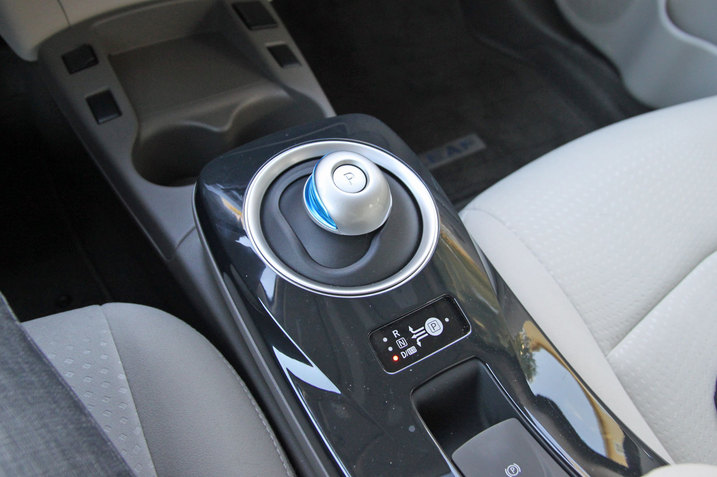
I'm guessing a mouse is what Nissan was going for when it came time to design the shifter in the Leaf. Problem is, no matter how much computing power is buried within the Leaf's dashboard, it's still a car.
Reaching down to put into gear is not a pleasant process with this little nub thing. There's not much to grab and it doesn't feel natural moving from one gear to other. Of all the things Nissan could have done to get creative, messing with something as simple as the shifter was not the best move. Should've conserved all that energy for the exterior, definitely needs some help there.

I'm fascinated by the concept of driving around on pure electricity, and I'd love to see the technology eventually work as a real-world alternative to internal combustion.
But beyond the issues of cost and range there remains perhaps the biggest challenge that won't be easily solved — charge time. When I drove our long-term Nissan Leaf home a few weeks ago the range went from 95 to 24 miles.
That wasn't so troubling, but I did drain over 75% of the battery and I don't have a 240V charger at my house. When I saw the charge time for my 110V home outlet I realized I couldn't leave the house until lunch the following day (I was plugging in around 6 p.m.) if I wanted the Leaf fully charged before driving it again.
That's a loooooong time for a fill-up, and one that the majority of new car buyers couldn't deal with on any regular basis. One solution is to have pre-charged batteries at corner locations, just like gas stations. You drive in, swap batteries and drive away taking no more time than a current gasoline fill-up takes. Let's see if we can make that work.
'Til then these cars are going to have very limited real-world application.

I learned something new that our 2011 Nissan Leaf and Infiniti M56 have in common. They both have two clocks that don't communicate with each other. You can't just change the time on the center stack. You have to do it on the IP display also. Nissan, this is unnecessary. Please, stop.


The first time I drove the Leaf I was pleased to find this fairly simple center stack layout. For a car with so many possibilities for gadgets and buttons, the designers clearly showed some restraint here.
It's not exactly a perfect layout — there are no tuning and volume knobs for instance — but for the most part you can pretty much take a quick glance over and find what you need instantly. This is becoming increasingly difficult these days even in normal cars, so the fact that Nissan kept it simple in its bleeding edge electric is a positive sign in my book.

Check out the nice-looking aluminum valve cover on our 2011 Nissan Leaf. That's what we like to see. Much better than all that plastic.
Hold on a sec...this sucker's electrical...

The "valve cover" in question is in fact an access cover for the power inverter that feeds the main electric drive motor (or "traction motor" if you want to get all nerdy about it) that sits directly below. Inside is a bunch of high-voltage electronic bits that get hot, hence the aluminum.
Still, it's ironic that an electric car like the Nissan Leaf makes a better underhood first impression than many regular cars.

I spent the last few days in our 2011 Nissan Leaf in order to restore the balance of nature after driving a Ferrari FF in Italy. Also because I wanted to. I drove it to and from work a couple of times and wheeled it all around Orange County over the weekend, racking up some 350 all-electric miles or so in the process.
Since I live 49.5 miles from the office — a 99-mile round trip — the availability of a charging at work is essential. There's no way I could regularly pull this off without the ability to top up the battery at both ends, even when driving conservatively.
Why? The EPA lists the Leaf's electric range at 73 miles. Not nearly enough for me. Furthermore, our testing so far indicates the EPA estimate is pretty accurate. Of 28 total battery charges to date, my 76.7-mile run is the best range any staffer has yet managed.
In so doing I went about as far into the low battery warnings as I'd ever want to on a regular basis. Here's how those warnings play out...

Note: the following odometer and trip meter readouts do not apply. These shots were taken at different times, but they still illustrate the point.
Four things happen at once when the fuel gauge first touches red. In my case, this happened when the range dropped into the neighborhood of 14 to 16 remaining miles.
A low battery text message comes up in the center of the dash, while a yellow plug-in icon illuminates nearby. More obvious is the range display (distance-to-empty readout) which begins blinking. Here the numeral "16" is a bit dim because my camera caught it mid-blink. Finally, the nice nav lady chimes in with "your battery is low".
In a gasoline car, you'd simply stop right now, anywhere. But here in an e-car you have no choice but to press on (or make a u-turn) to the nearest station, which in this case is my own house. I timed my trip properly, so I was already pointed toward home when this happened.

Warning level 2 is triggered when the fuel gauge retreats to one red bar, at which point the DTE gauge winks out and stops telling you anything at all. I'm not sure if this is worse than knowing the actual number or not. I think I'd prefer the bad news to this hidden surprise.
In the end it doesn't matter either way because you can't make it very far. You'd better be quite close to your destination at this point.
For me, the last reading I saw just before "- - -" was 8 or 9 miles. In both cases I was just around the corner from my driveway. It was no sweat.

But the simple change to "- - -" miles isn't the whole enchilada. Warning level 2 also includes another polite verbal from the nav lady. This time she says "very low" instead of low, as do the written messages on the nav and main message center screens. It's all very hard to miss.
If the HVAC is on, it'll automatically tell you how many extra miles you'll get by shutting it off. Don't expect much. A button also appears; it leads to a map of nearby charging stations. In my case there was but one station — my own house. The Leaf, you see, remembers the GPS coordinates of every place it was ever plugged in.
Interestingly, my best range of 76.7 miles came without descending into warning level 2 — not quite. That's not really an ultimate range, of course; it's more of a useful range.
The true range of the Leaf is ultimately the point at which you start to feel quite nervous about running out. So far, our experience indicates the EPA's official published range rating of 73 miles is just about right.
Don't plan on driving the Leaf to it's ultimate range unless you have your own tow truck. We'll do that in due time so you don't have to. We're curious what the subsequent warnings look and sound like, too.
Maybe the nice nav lady starts screaming and yelling, or something.

The shift lever on the 2011 Nissan Leaf shows that there are two drive positions — drive and ECO mode. You can put it into ECO mode by moving the gear selector into D twice. The manual says that ECO mode will extend the range by increasing regenerative braking, cutting power to the climate control system and limiting acceleration. I chose ECO mode last night and embarked on my 31.5 mile commute home.
First thing I noticed was that the power was greatly reduced and the Leaf was suddenly no fun at all to drive. It felt like it had been drugged. But I stuck with it to see how much it would extend the range. I don't know if I was imagining things or not, but the predicted range seemed to bounce all over the place more than in the normal D position. When I got home I had covered 31.5 miles but used 35 miles of the predicted 95-mile range. So it didn't seem to extend the range at all.
This morning I went back to using the normal drive position and the Leaf seemed to come alive. I drove around near the office and when I pulled back into our garage I had covered 66.4 miles and had 18 miles left on this charge. So that totals 84.4 miles, which is a little better than we have been getting and better than the EPA's 76 miles of expected range.
So when I get my own Leaf, I won't be cruising in ECO mode, unless it is a choice between that and walking.

Cars like the 2011 Nissan Leaf, Toyota Prius and Honda Insight are all about their unique fancy-pants drivetrains, but they're supposed to be affordable, too. Experience tells us this combination produces few surprises in the suspension department.
Still, the Leaf was the landslide winner in our recent suspension walkaround poll. You asked for it, you got it. Here's the all-new 2011 Nissan Leaf in a compromising position in my driveway.
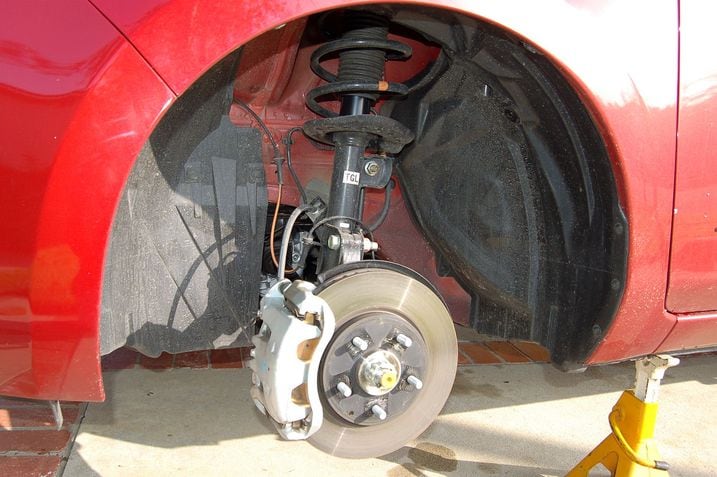
To the surprise of no one, the Leaf's front end is propped up by MacPherson struts.

The lower control arm (yellow) is of the one-piece stamped steel variety, and it pivots on two simple bushings.
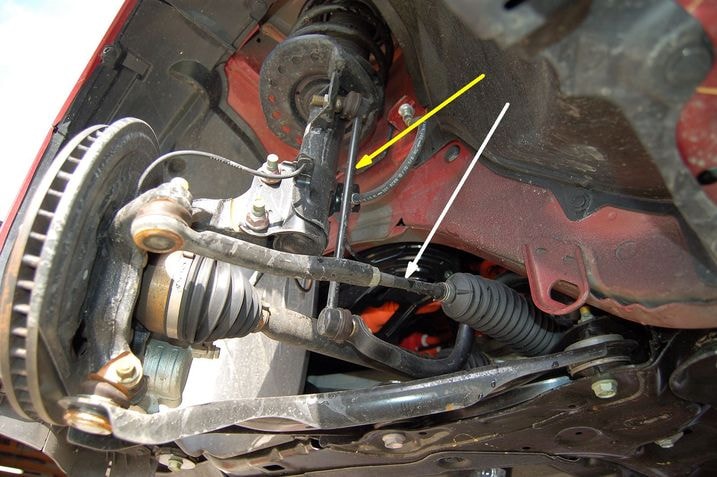
The Leaf's electric-assist power steering (white) operates from behind, just as it would in any other front-drive machine with a transverse engine — or in this case a transverse electric motor.
A long slender link (yellow) connects the stabilizer bar directly to the strut housing for a 1:1 motion ratio that extracts the maximum efficiency from the stabilizer bar.

In keeping with the mission and price point of this car, the knuckle is made of cast iron. Remember, all of the cost resides in the batteries and electric drivetrain.

The stabilizer bar (yellow) is mounted behind the steering rack, so it must bend and turn along a tortured path to arrive where the drop link can meet it.
Check out how small the locating bushings are for the L-shaped lower control arm. We can't see it, but the front one in the crook of the L is bound to be much firmer because it handles most of the lateral cornering loads. Because it's so small, it might just be a pillow ball in this case.
The rear one will be softer so it can absorb any fore-aft impacts seen at the wheel. Imagine whacking the ball joint in the foreground left-to-right with a hammer. The harder forward bush stays put and acts as a pivot, sending your hammer blow into the picture toward the center of the car at the rear bush. That's how the fore-aft component of a pothole strike gets absorbed.
Of course the up-down portion of the pothole strike gets handled by...
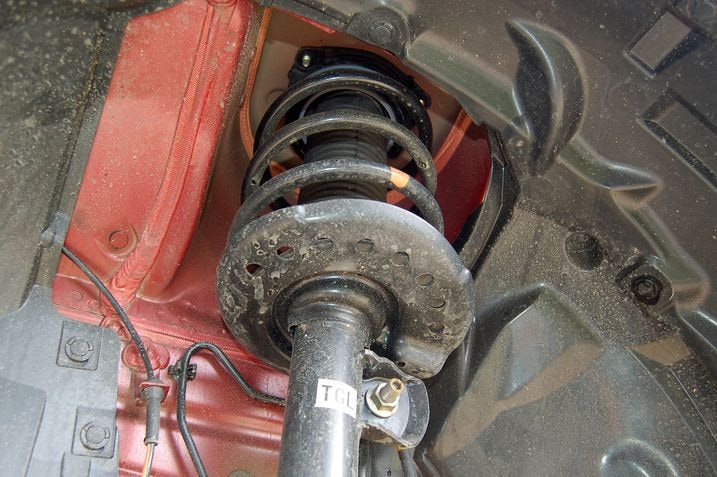
...the spring and damper, of course. Yes, it rained the day before I shot these pictures. Dirt everywhere.

The most surprising element of the Nissan Leaf's suspension has got to be these brakes. As you can see they are two-piston calipers. I'd have thought a car of this size and weight would have no trouble with single-piston calipers. We almost never see dual-piston sliders until we get to something the size and weight of a Ford Flex.
And that's before you factor in the serious amounts of regenerative braking afforded by the electric motor. These babies are going to be very lightly used much of the time.
Still, the brakes have to be certified without the help of regenerative braking, and the Leaf does weigh almost 3,400 pounds. Its small wheels mean small rotors, which means little leverage for the brake calipers. It may well add up. Nissan wouldn't go to the extra expense unless it was warranted.
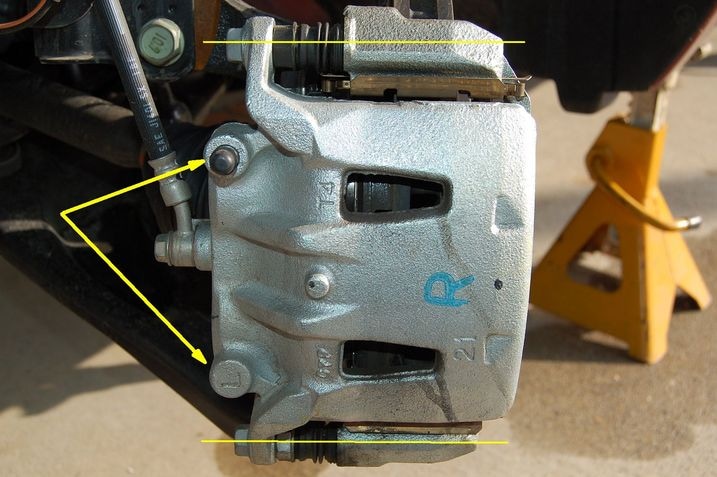
This is a symmetrical brake casting used on both sides of the car. If you look carefully you'll see that the bleed fitting at the top has been screwed into the letter R, leaving the letter L opposite untouched to signify this as a left front brake. On the other side the L is pierced and the R is intact. The big blue inked R means something else entirely.
The slender lines indicate the pins on which the caliper slides as the brakes are pressed.

Out back, the Leaf is suspended by a simple twist beam axle.
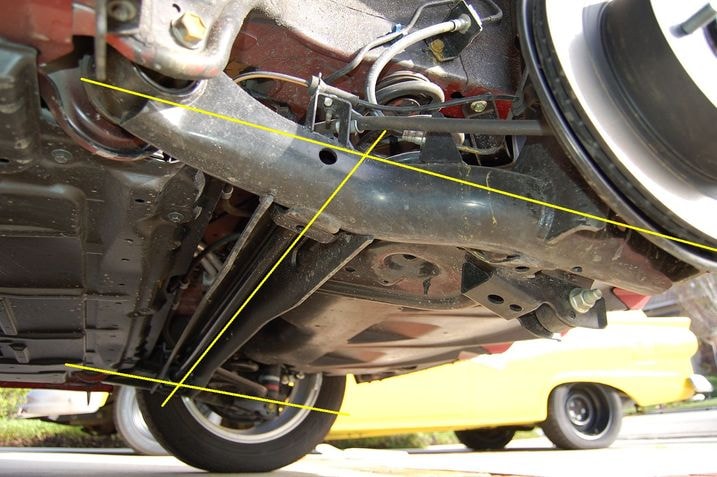
A twist beam is one large piece that's welded together from several smaller parts. Because of this it's not a fully independent type of suspension, but we can call it semi-independent because the central beam that spans the car is designed to twist so the wheels do experience at least some independence. In reality a twist beam axle is a giant stabilizer bar with wheels on the floppy ends.
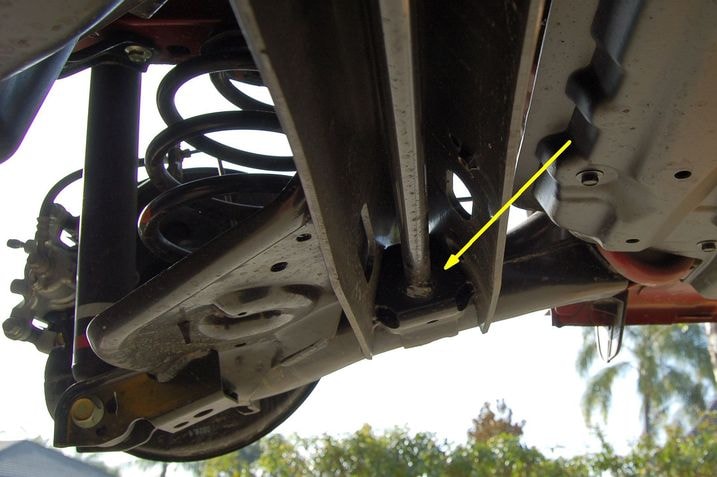
Technically, we can't call this part the stabilizer bar because the whole twist beam is a stabilizer bar, but this welded-in supplemental stabilizer bar serves no other purpose than to increase the roll stiffness of the entire twisty beam to a point where the engineers are happy.
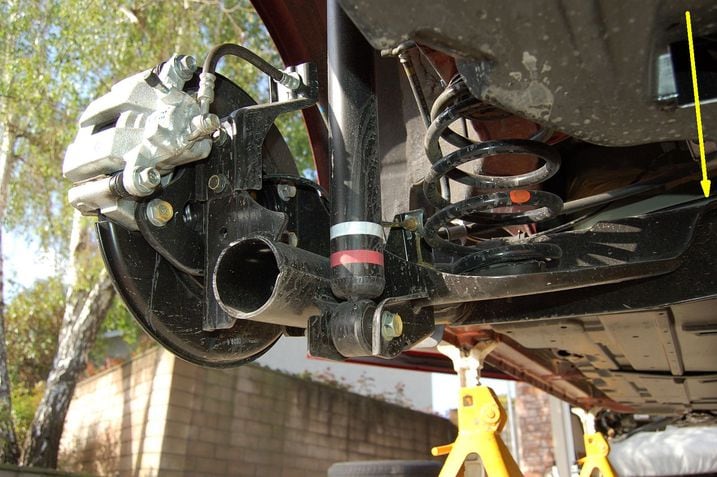
Because the spring platform and the other welded-on bits act like huge gussets, the twist beam doesn't twist much until you venture inboard of all this stuff to where the beam is just a beam.
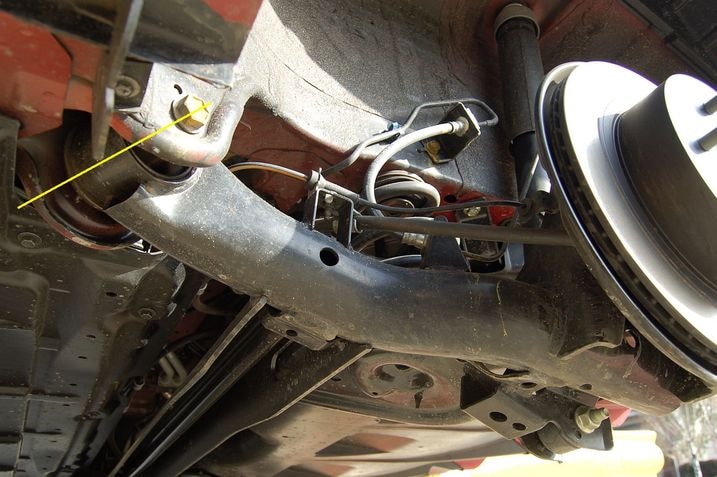
This bushing and its opposite number on the other side are the only places where the twist beam is located in 3D space and attached to the car. These pivot bushings, therefore, are very important.
In the interest of harshness — the fore-aft component of impacts — you want them soft. But if they're soft they will deflect in corners and create the dreaded roll toe-out, otherwise known as roll oversteer. Bad news.
The compromise solution everyone has adopted is this angled orientation of the bushings.
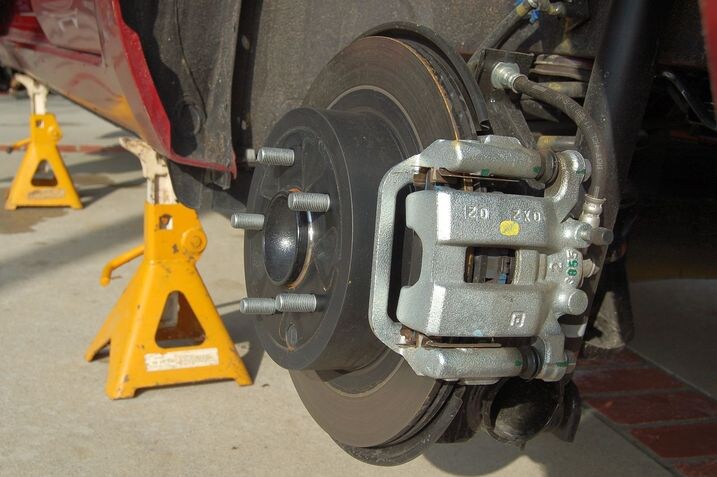
Ventilated rear rotors and single-piston sliding calipers slow things down in the rear, but the Leaf's parking brake is a cable operated drum that's hidden inside the rotor's "hat" section.

Bridgestone Ecopia low rolling-resistance tires are the standard fitment. They weigh 41.5 pounds mounted and ready to go on their cast-aluminum wheels.
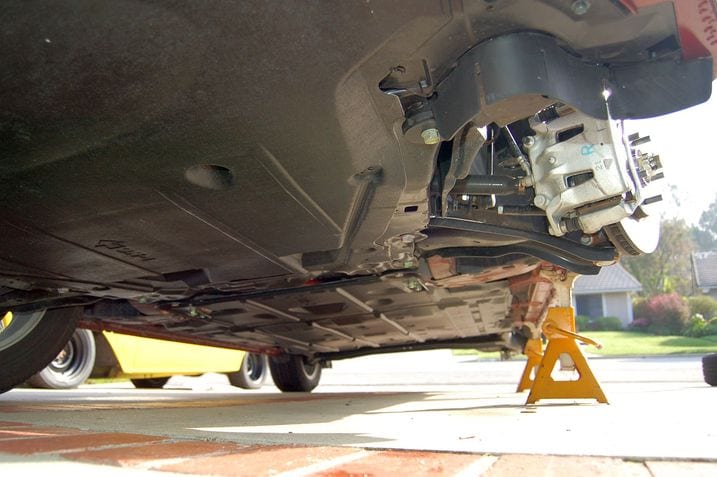
We saw nothing of the Leaf's electric drive system or its batteries this time because it's all hidden by these aerodynamic belly pans. Maybe next time I'll dig out some wrenches and take a peak. I'll need a more traditional 2-post garage lift to do that justice, I think.
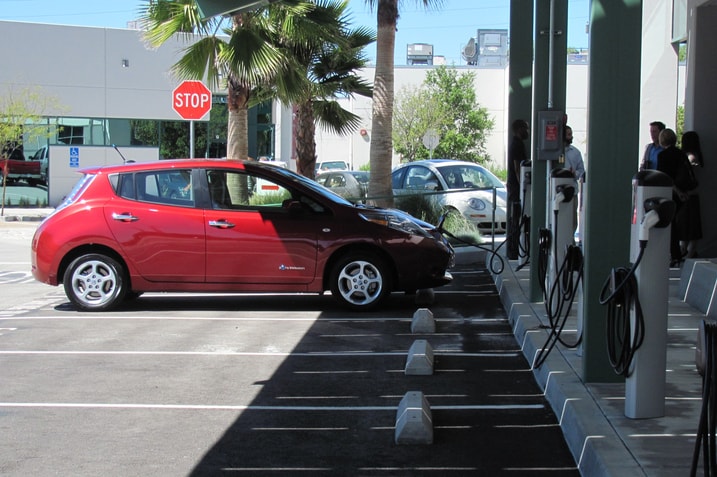
A few of the Edmunds editors and I recently visited the "Smart Energy Experience" exhibit at Southern California Edison's CTAC Energy Education Center, in Irwindale, Calif. Since the Smart Energy Experience is a showcase for the utility company's latest advancement in electricity metering and management, we thought it would be appropriate to drive there in our long term Nissan Leaf.
The facility is about 37 miles away from our offices. Round trip, that's 74 miles — too close for comfort, given that the Leaf's EPA range is 73 miles. With some planning however, we were able to take this EV past its round-trip limitations. Edison's staff said we could use their level 2 chargers and since we planned to stay there for a few hours, we could "top off" before heading home.
The trip to the facility drained about 60 percent of the Leaf's charge. There were three people in the car, the A/C running at 73 degrees and we were traveling at an average speed of 65-70 mph. It was a particularly hot day (about 90 degrees) and we went up a few hills, which further contributed to the battery decrease. The remaining range read about 45 miles when we got to our destination.

When left the center about three hours later, we saw another Leaf parked and plugged in next to ours. We snapped a quick photo and headed back to the office. With three hours on the charger, the Leaf's battery was close to 90 percent. The return trip didn’t drain the battery as much, since the car was coasting down the hills we had climbed earlier. We also caught some traffic, which decreased our average speed. Back at the office, the Leaf had a remaining range of 54 miles. Impressive performance, given the conditions.
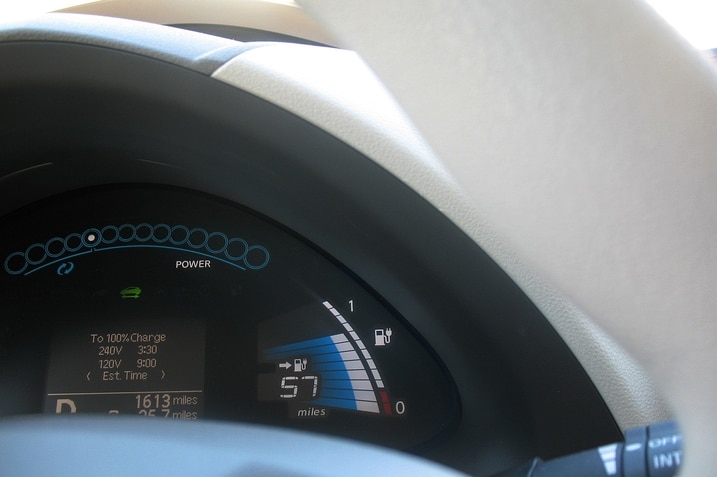
I live in West L.A. in a neighborhood that's perhaps less sprawling and more pedestrian-friendly than your typical SoCal enclave. There's a Walgreen's within walking distance (open 24 hours for your 'round-the-clock shopping pleasure) and a Whole Foods just a couple of minutes away. I can get to movie theaters in less than a mile and I can stroll to the eateries of 3rd Street and Restaurant Row if I'm feeling so inclined.
As is often the case, the stops on my weekend itinerary involved destinations that were all within the immediate 'hood — all within a mile or two. A couple of trips to the grocery store. A trip to a nearby restaurant to get the lowdown from an old friend who recently quit her job. A visit to KMart for a replacement water filter. The weather was on the warm side so I kept the Leaf's air on all throughout.
On Monday morning after the 6-mile drive into work, I had 58 miles of range left, according to the ol' range-o-meter; keep in mind that I'm not set up to charge at my apartment so the car's last charge was at work on Friday.
Electric cars won't be everybody's glass slipper but given the fact that I typically don't have a need for too much range, the Leaf strikes me as being a great little city car for my needs.

One of the things that can be most frustrating about electric cars like the Leaf is the lack of transparency when it comes to the cost of power consumption.
It's easy to tell exactly how much it costs to fuel your Accord each week — and to make reasonably accurate predictions regarding the weeks ahead — but for electric vehicles, the picture becomes more nebulous.
Complicating things further is the tiered rate system that we have here in California. Under this system, your electricity rate is dependent on the amount you consume; the more you consume, the higher your rate.
During our recent trip to Southern California Edison's Energy Education Center for the"Smart Energy Experience" exhibit, I got the chance to learn about SCE's plans to make power consumption more transparent.
The utility is rolling out Smart Grid technologies that enable you to monitor your power usage as it happens. For example, if you plug in your Leaf for charging, you'll be able to see via a display like the one shown above exactly what kind of impact it's having on your electricity bill.
Seems like these kinds of technologies can serve to make cars like the Leaf a more practical proposition for the average consumer. What's your take?

One of the things that can make electric cars a no-go for many is the fact that since the nationwide charging network still has some growin' to do, you could find yourself struggling to find a charging station on longer journeys. Well, there's one solution for that problem that you may not have thought of: campgrounds.
Turns out that most campgrounds and RV parks are equipped with 240-volt hookups that allow you to fully charge electric cars like the Leaf in just four hours. There are a few campgrounds in Maryland that are already marketing this service, to accommodate EV drivers visiting Washington DC from cities in the north. The cost for a four-hour charge seems to run between $8.50 and 10 bucks.
You'll need to bring your own adapter in many cases, but as more and more campground owners start marketing this amenity, it's expected that increased demand will result in the building of designated EV pedestals.
So what do you do while you're gettin' all charged up? Says Russ Yates, owner of a Maryland campground: "Most people who come to our park to recharge their vehicles come up to our store and buy snacks. Or they get on their laptops and send email. But most of them simply take a nap in their vehicle or they walk around our park and sit by the river."
Any EV owners out there? Ever charged your car at a campground or RV park?

I signed out the Leaf about an hour before I was notified that I had to return home to tend to a very sick pet. My heart sank. Besides the fear of losing a beloved furry companion, I was filled with dread because the Leaf probably isn't the best car in an emergency. What ifs. All sorts of what ifs popped into my head as I stood in front of my desk. What if I need to travel further than I had planned? I was paralyzed, sweating profusely. After a few choice expletives under my breath, I grabbed my stuff and bolted for the door.
I got to the Leaf, just as Riswick was getting into the Volt. I was a mess, I didn't really know what I was doing with the Leaf. I unplugged it, and hopped in. Riz scampered to the front of the Leaf and shut the charge port door that I forgot about. We flashed a quick thumbs up to each other and I was out of there like an F1 pit stop; a very, very slow pit stop.
Traffic. At 3:30 in the afternoon. This is not what I needed. I kept my cool, but this gave me far too much time to ponder the worst case scenarios. More what ifs. The freeway was crawling at a walking pace, so I switched to Eco mode just in case I needed more range later. The Leaf's crypt-like silence may be calming for some, but at that instant, it just made me feel alone and isolated. Get me home. Please, just get me home.
My mind lingered long enough on range anxiety to realize that this should not be someone's only mode of transportation — solely for times like this. A while back, my father had a heart attack and I rushed to the hospital in my Lotus. I think I set a new urban speed record in the process. I'm not saying that a sports car is the best vehicle when a crisis breaks, but something reliable with a decent amount of range is.
In seismically active Southern California, the Leaf would be one of the worst choices when the big one hits. Power would likely be out for weeks, so charging is out. That means getting around just got more complicated. In the event the shaking gets bad, I have some power inverters so I can use a car as a makeshift generator and I usually have more than a half tank of fuel in the cars/bikes. This obviously would have limitations if the leaf were the only car in the driveway.
Back to the present emergency. I got home and loaded the cat in the carrier. The Leaf's crypt-like silence seemed like a good thing on the way to the vet, as the little guy didn't need anything to stress him out any further. No word on what ails him yet, fingers crossed. Perhaps I should sign out the Volt until I know for sure.

(Photo by Mark Takahashi)
Nissan is investigating complaints in the U.S. and Japan that the Leaf fails to start on occasion. "Nissan has recently become aware of an issue on a small number of Nissan Leafs with a sensor in the air conditioning system," said Nissan Americas statement on Monday.
"If the sensor is activated, it will illuminate a warning light on the instrument panel and may cause the vehicle to not restart once it has been turned off. We are actively investigating to determine the root cause and what action is necessary to address the issue. This is not a safety issue as the vehicle will not stop running while being driven, but may not restart after being turned off."
At this time we have not experienced any such problem with our Leaf.

Our 2011 Nissan Leaf is headed to our test track at Auto Club Speedway in Fontana. Technically, it can make the drive from Santa Monica to Fontucky on a full charge, but the distance is such that it would arrive with precious little juice left for testing.
Since our standard procedure is to test all cars with a full gas tank and/or a full battery, the journey has become a two-vehicle, two-step process. Step One consists of the Leaf spending the night at my house getting juiced up. Step Two involves our 2010 Ford F-150 SVT Raptor and a U-haul trailer, both of which stand ready and waiting nearby to drag the Leaf and its fully charged battery out to the track tomorrow morning.
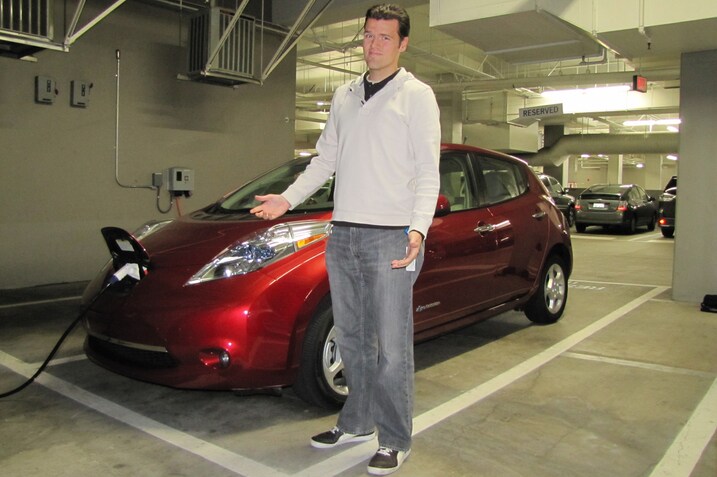
Oh, you're all so very funny, aren't you? I let you pick my ride to Las Vegas and you go ahead and choose the Nissan Leaf. Hardy har. Magrath gets a 412-horsepower Mustang, and I get the electric car. Jerks. I'll see you in three weeks.

Our Honda Insight gave us flowers. The Fusion Hybrid grows a patch of leaves. The Nissan Leaf? Trees. I like these visual incentives. It makes driving like an octogenarian tolerable. I attained the first tree pretty easily; within the first seven miles of my drive home. By the time I hit 10 miles, I had a tree-and-a-half. According to the owner's manual (which appears to be printed on recycled paper), the display maxes out at three mini trees and one big one. I'm on a mission to someday get all four.
Now I'm wondering how much fun we can make these incentives...
Maybe we can start with a cartoon of a regular guy. As you drive more eco-friendly, he begins to transform into a hippie — his beard gets longer, his clothes goes tie-dye. Keep going, and maybe his old lady appears and at the final level, they start freeform dancing.
Or maybe we go with a middle-eastern despot. The more eco points you earn, the angrier he gets; ending with cartoon steam jetting from his ears.
We can also think up some visuals for when you're not driving economically. I always thought that the Ford Fusion Hybrid's leaves should burst into flames and rain down in ashes when you lose one. Maybe our hippies start giving you the stink eye like you just harshed their buzz, and our oil despot begins to smile demonically, greedily rubbing his hands together?
Ok, maybe the trees are a good idea after all.
What would you like to see as an eco-indicator?
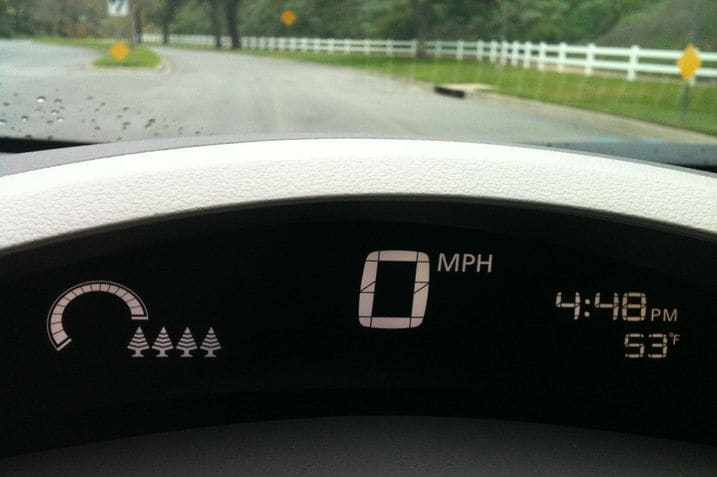
Sorry Mark. Here is photographic proof that the 2011 Nissan Leaf can grow more than 1 large and 3 small trees. Check out the forest I had going after a semi-slow freeway ride home a couple weeks back: four grown, working on number five. Oh yeah.
What is the maximum number of happy little trees the Leaf can grow? We plan to find out in a little test we're cooking up for next week.
Bob Ross would love it.
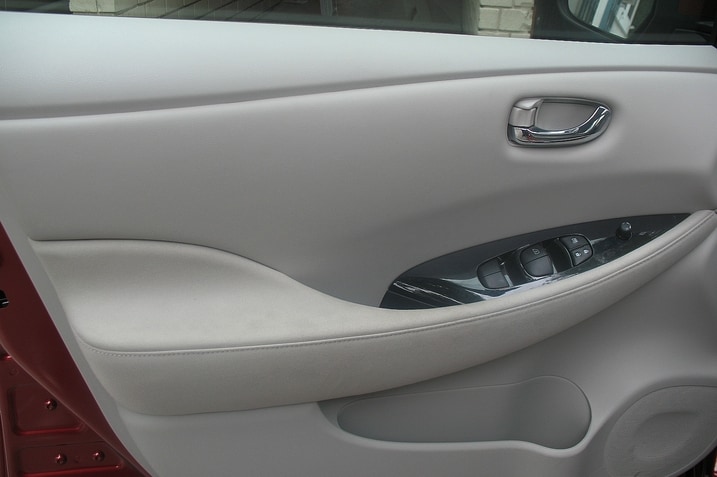
The upholstery in our Leaf kinda reminds of that seen in our departed Prius. The fabric in both vehicles is light-colored and very soft — almost velour-like — to the touch.
So that means it feels great — way to go, Leaf — but it could also mean that, like the Prius, the Leaf's upholstery may not exactly be a champ when it comes to keeping dirt and grime at bay.
Nothing yucky to report just yet. We'll see how it holds up.

I wind up picking the Leaf a lot as my ride for the night and the reason for this is simple: The little green-natured Nissan is pretty enjoyable to drive.
Other electric cars I've piloted require you to alter your expectations when it comes to driving dynamics. Our Mini E, for example, had aggressive regenerative braking that took some getting used to, serving as a constant reminder that you were driving something markedly different from the typical gas-powered hauler.
But there's none of that with the Leaf. In general, its reflexes are pretty sharp, even relative to those of rival gas-powered models. The electric motor offers ample torque down low and it's delivered immediately; punch the pedal and the Nissan goes with no hesitation. Even though the Leaf has electric power steering, steering feel is natural and never overboosted. And those brakes? They feel certain and firm.
Many think that dull handling is part of the package with electric cars but the Leaf proves that this doesn't have to be the case.
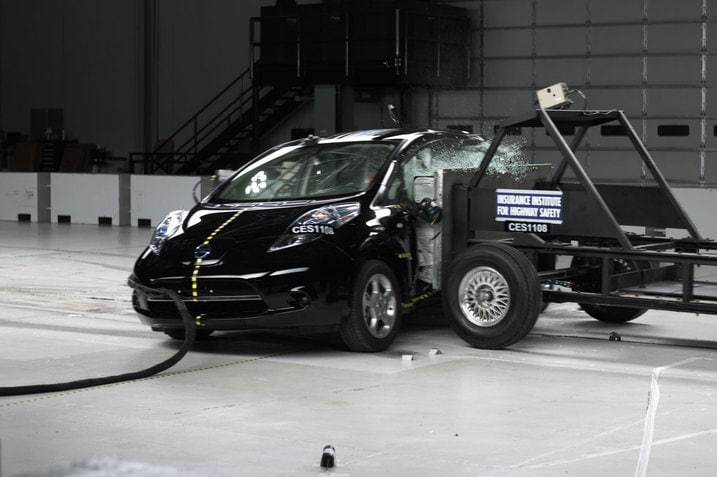
On the same day, the Volt crash tests results came out, the Insurance Institute for Highway Safety (IIHS) released its findings for the 2011 Nissan Leaf. These ratings were also stellar, as the Leaf is rated "Good" for frontal-offset and side-impact crash safety, along with roof strength and head restraint effectiveness.
Lest you think this is in relation to other subcompact or compact cars, note that the IIHS considers Nissan's EV midsize based on interior volume, so these ratings are directly comparable to the Volt, Accord, Sonata and other family cars.
More details on the Leaf's crash test performance can be found here, and there are more photos and video after the jump.
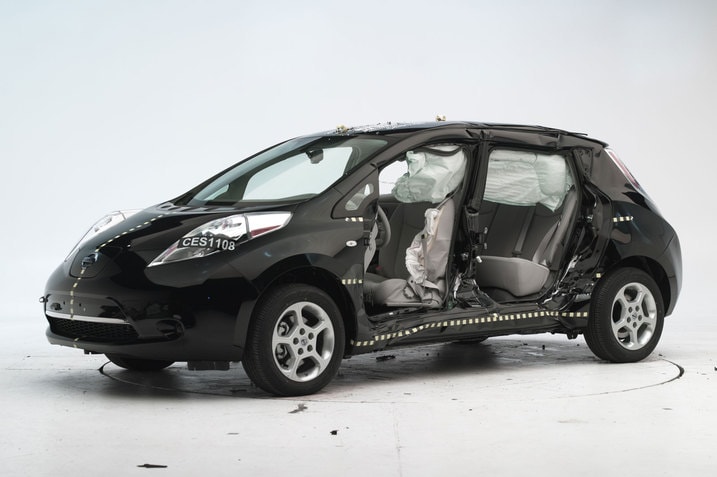
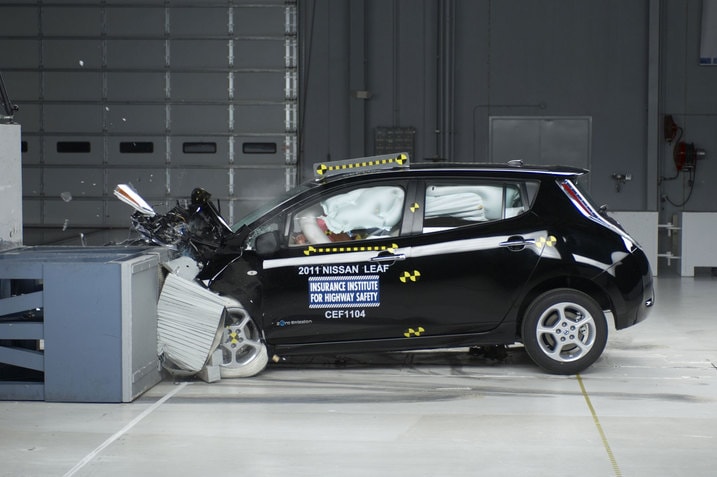

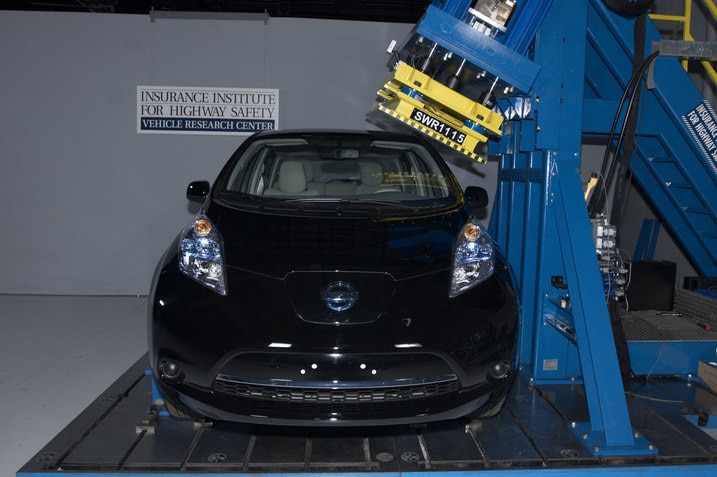
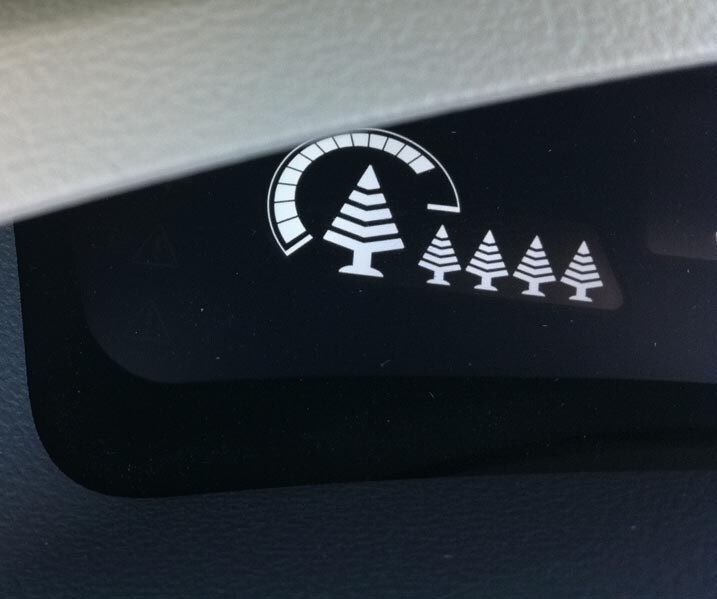
Watching Mark and Dan struggle to count trees recently was fun, but I win.
I got all of the trees the first day I spent with our long term 2011 Nissan Leaf SL back in March. What can I say, I like games. As soon as I read the manual and found out the max number of trees (four small, one big) I was determined to get it IN THAT DRIVE. It took some miles and a whole lot of pointless driving, but it was almost too easy. Like a really unrewarding final boss in a video game, it was just ...over.
We need a tougher sequel.

By now you kids know the drill: If it's a long-term car, we're going to send it to the track to test it. Even if it means we need to have a tow-truck to bring it out and bring it back. Which we absolutely had to do with our 2011 Nissan Leaf SL. Forget the testing, our Leaf wouldn't even make it to the track and back without the full-throttle shenanigans we do out there. (Traditionally powered cars average in the mid/low-teens for fuel economy during testing.)
So with a full charge and an empty facility, we set out testing the mass-produced full EV to see what it was capable of when economy was thrown out the window in exchange for handling. If EVs want to be accepted, they need to drive right, right?
Specifications:
Drive Type: Transverse, front-electric motor, front-wheel drive
Transmission Type: single-speed direct drive
Battery Capacity: 24 kWh
Horsepower (hp @ rpm): 107
Torque (lb-ft @ rpm): 207
Steering System: Electric Speed-proportional power steering
Suspension Type (front): Independent MacPherson struts, coil springs, twin-tube dampers, stabilizer bar
Suspension Type (rear): Semi-independent twist beam-axle, coil springs, twin-tube dampers, integrated stabilizer bar
Tire Size (front): P205/55R16 89h
Tire Size (rear): P205/55R16 89h
Tire Brand: Bridgestone
Tire Model: Ecopia EP422
Tire Type: All Season
Wheel size: 16 inches front and rear
Wheel material (front/rear): Aluminum Alloy
As tested Curb Weight (lb): 3,364
Test Results:
Acceleration
0-30 (sec): 3.4
0-45 (sec): 6.1
0-60 (sec): 10.2
0-60 with 1-ft Rollout (sec): 9.9
0-75 (sec): 16.4
1/4-Mile (sec @ mph): 17.5 @ 75.9
Braking
30-0 (ft): 33
60-0 (ft): 130
Handling
Slalom (mph): 60.3 (58.1 with T/C on)
Skid Pad Lateral acceleration (g): 0.78 (0.74 with T/C ON)
Sound
Db @ Idle: 38.3
Db @ Full Throttle: 65.8
Db @ 70 mph Cruise: 63.7
Comments
Acceleration: Test run after slalom and skidpad with about 60% of charge left. Will retest another time to see if 100% charge makes any difference. As it was, a coordinated two-foot transition from brake to throttle is better than brake torque or whack-n-go.
Braking: Pedal is relatively firm and not overlong, but stops are punctuated by early and persistent ABS intervention and so-so stopping distances.
Handling: Skidpad: With ESC off (and it does shut off) there isn't much grip from these tires but the ability to alter the attitude of the car with throttle response is pretty remarkable. Steering feels spring-loaded, but I was mostly steering with the throttle. With ESC on, it takes throttle away first, then dabs brakes. Slalom: Whoa! My first pass let me know by the second cone how reluctant the Leaf is to changing direction in a hurry. It understeers initially, then oversteers with the opposite input for the next cone. It's a handful with ESC off, especially with all the body roll. ESC is pretty effective and minimally intrusive if kept close to its limits — exceed them and it punishes.

We've all been curious since Day One; you've asked for it, we've wanted to do it. Now, at last, we know how far our 2011 Nissan Leaf can go on a single charge. And we also know what this electric car goes through as it slowly convulses and dies at the side of the road.
This last point is why it took so long to arrange this test. Crapping out on some random road or freeway with unknown emergency parking and uncertain traffic simply wouldn't do. Sure, we could have done it at 2:00 am somewhere, but the video would have been a little, shall we say...dark.
Besides, we were going for distance. To do that we would need to drive the Leaf slowly for miles and miles of uninterrupted miles with no traffic. What we needed was a big oval test track, a place where we could set the cruise, settle in and run the most boring laps imaginable while the Raptor and its rescue trailer sat in the shade, waiting for a radio call.
For no other reason than it sounded about right, we chose 35 mph as our test speed. We've heard tales of a Tesla running some amazing distance, but they supposedly did it at something like 17 mph. We'd shoot ourselves if we had to drive that slowly for an estimated 9 or 10 hours — without cruise control, mind you, because it won't work at such a snail's pace.
To us, 35 mph sounded like a reasonable slow speed, something that reasonable people might actually average in a suburban setting. Something our drivers might stand a reasonable chance of staying awake for.
How far did our 2011 Nissan Leaf take us at a steady 35 mph? Find out after the jump.
Nissan's initial claim for the Leaf centered around 100 miles. They also said that specific driving conditions could drop that figure to 62 miles or raise it as high as 138 miles.
The Leaf's official range, as measured by the EPA and displayed on the window sticker, is 73 miles.
But all of those figures come from tempearture-controlled indoor dyno chambers. None are based on actual driving in the outdoors.
Nissan's maximum data point suggested that our Leaf would be circulating the big, flat oval for something like 4 hours at our target speed. We allowed ourselves 3 stops so we could spread the pain out over four drivers and preserve as much of their weakly-held sanity as possible.
We also kept the climate control system off. Temperatures approaching 80 degrees forced us to allow ourselves to crack the windows open enough to get some air moving in there, but at just 35 mph the aerodynamic effects wouldn't hurt us near as much as running the AC would have.
In the end, our 2011 Nissan Leaf went 132.0 miles.
Interestingly, the sum of the trip odometer and the distance-to-empty (DTE) gauge started predicting something very close to that neighborhood about 15 miles in, the point at which it must have decided that our current driving pattern was persistent enough to use for estimation purposes. Not surprisingly, our Leaf's dash grew the maximum five trees within the first 50 miles.
At 112.4 miles, the DTE meter began blinking "20" miles to go as the Leaf got down to two "bars" of electricity on what for lack of a better term we'll still call the fuel gauge. We've been here before lots of times, but never at a distance remotely close to this.
Then, at 122.0 miles, the gauge dropped to one bar of electricity and the DTE prediction of 11 miles to go winked out and was replaced by "- - -" miles instead. We've only driven a couple of miles past the "- - -" point in real life before wimping out and plugging in, but this time we were going all the way.
At 130.0 miles, the final bar of electricity disappeared from the fuel gauge and the dreaded Tortoise lamp came on, indicating that power and speed were being cut. Speed did indeed drop to 33 mph for a time, but it soon came back up to 35 for a short time before faltering once again.
The Tortoise light went out again at 131.2 miles and an excited red triangle winked on as the Leaf's speed began a steady retreat. I was in the car at the crucial moment and counted it down, reverse Top Gear USA-style, "...18...17...16...15." Our red Leaf finally came to a dead stop after exactly 132.0 miles, 10 miles after the DTE gauge stopped making any promises.
The trusty Ford Raptor swept in to clean up the mess shortly thereafter. Thankfully, the Leaf's power windows still worked and we were able to easily shift it into neutral and steer it onto the trailer with a gang of people pushing. We towed our fallen Leaf off the track and plugged it in to see how many kilowatt-hours (kWh) it had just gone through.
It took 26.08 kWh of juice to recharge the battery, which works out to a consumption rate of only 19.8 kWh per 100 miles. The most we'd ever put in previously was 24.35 kWh, after a real-world random drive of only 71.2 miles and a DTE reading of 7 miles.
Our own day-in day-out random testing tells us the EPA rating has the Leaf's useable range pegged just about right. But on what is essentially an infinitely long straight and level road, at a steady 35mph on cruise control, with the AC off and the windows cracked, our Nissan Leaf will, in fact, go 132.0 miles on a single charge.
To do this again we'll have to rent this track or another one like it another time. Here's a poll for you: steady 65mph with the AC set to 75 degrees or full-whack wide-open throttle?
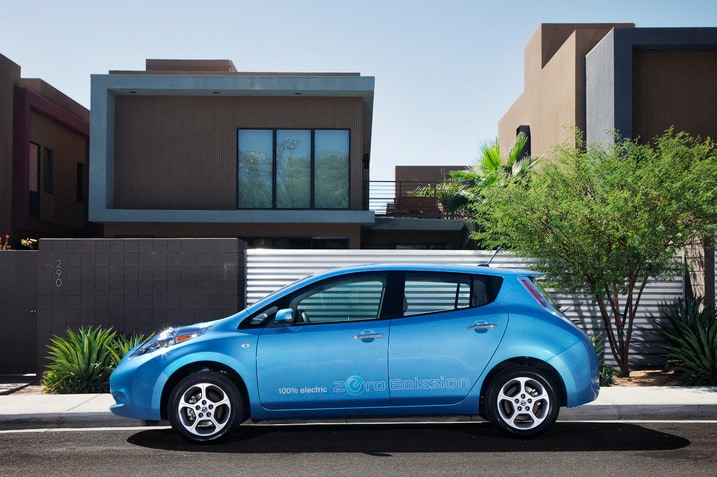
Are you the owner of one of the 1,044 Leaf hatchbacks that have found a home in the US since the car's launch in December 2010? If so, maybe you're wondering what your fellow Leaf owners are like, and how they interact with the car. Nissan has a few answers.
Via Carwings, the
spyware
telematics system that's standard on all Leaf models, Nissan has compiled aggregate data regarding the use patterns of the first Leaf owners. Here's the dirt:
-The average trip length of these early adopters is 7 miles
-Most charge on a Level 2, 220-volt charger at their homes
-The average charging time is 2 hours and 11 minutes
Reports Nissan: "Leaf owners are a combination of conscientious environmentalists and tech-savvy individuals. They are highly educated, have excellent credit, and are in the nation's top 15 percent for household income."
Any Leaf owners out there? Do these stats jibe with your own experience?
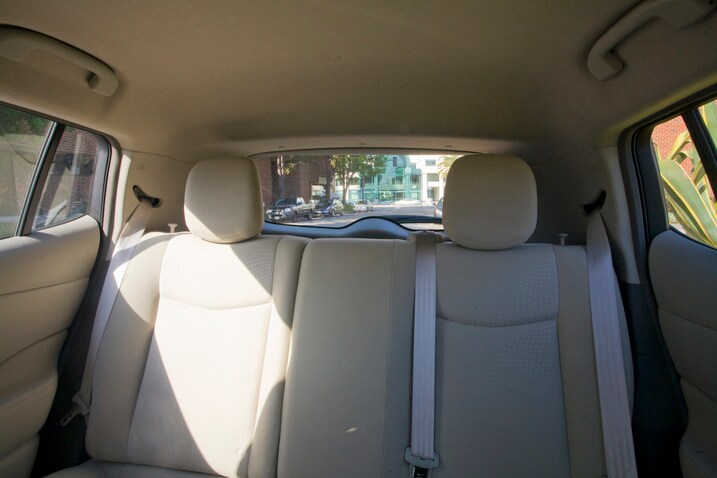
The more time I spend with our Leaf, the more I like it. There are only a few things I could complain about, and those items are admittedly negligible. Case in point: the rear headrests.
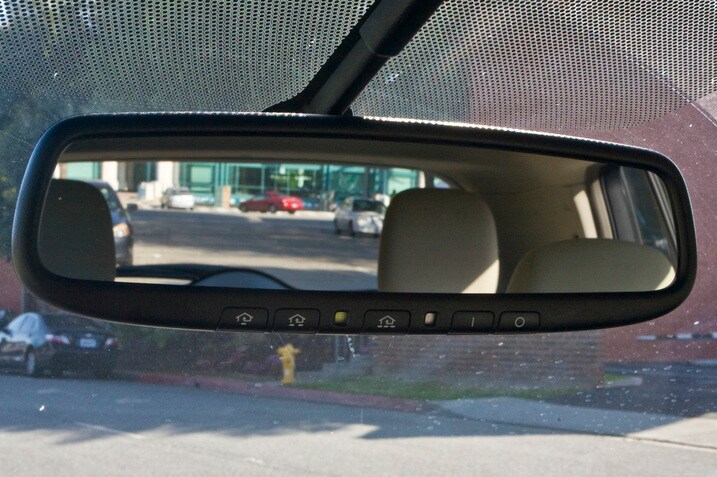
I'd like to see them flip down out of the way when not in use (which for me is always). Our Mustang has flip-down headrests and I think it's a great way to maximize available rear visibility. If the Leaf had a rear center headrest, I'd consider flip-downs a necessity. Some people would go ahead and remove them altogether, but I hate having things roll about in the trunk or in the rear seats.

Once again it's time to update the fuel and electricity consumption logs for our 2011 Chevrolet Volt and Nissan Leaf. At the shop, our Coulomb level II charger records the number of kilowatt-hours (kWh) consumed during each battery recharge.
What you see above is a Kill-A-Watt EZ, the home unit we use to measure the number of kWh needed to recharge away from the office. Each car carries one.
Here's what it all means with April added in...
| 2011 Chevrolet Volt |
Best |
Worst |
Average |
| Electricity (kwh/100 mi) |
26.2 |
52.0 |
34.8 |
| Electric Range (miles) |
47.0 |
25.8 |
37.5 |
| Gasoline (mpg) |
39.0 |
27.9 |
32.7 |
|
|
|
|
|
| 2011 Nissan Leaf |
Best |
Worst |
Average |
| Electricity (kwh/100 mi) |
24.2 |
53.8 |
31.5 |
| Projected Range (miles) |
104.0 |
65.8 |
85.6 |
| Observed Range (miles) |
76.7 |
|
|
Lower is better for consumption figures in kWh per 100 miles.
You may notice that the Leaf's 132.0 mile performance (at just 19.8 kWh/100 miles) has been excluded. That's because that was a "what if?" special test on a proving ground, not real driving on real roads. I think it's telling that the next-best observed range is 76.7 miles.
As before, the Projected Range is the sum of the trip odometer and DTE gauge readings when the car is plugged in. Our "Drive to the Bitter End" did indeed confirm that this is a pretty accurate estimate of ultimate range, but we also learned that you don't mess with the blinking "- - -" reading and you must fear the tortoise.
| 2011 Chevrolet Volt |
Best |
Worst |
Average |
EPA |
| Electricity (kWh/100 mi) |
26.2 |
52.0 |
34.8 |
36 |
| Electric Range (miles) |
47.0 |
25.8 |
37.5 |
35 |
| Gasoline (mpg) |
39.0 |
29.8 |
32.7 |
37 |
|
|
|
|
|
|
| 2011 Nissan Leaf |
Best |
Worst |
Average |
EPA |
| Electricity (kWh/100 mi) |
24.2 |
53.8 |
31.5 |
34 |
| Projected Range (miles) |
104.0 |
65.8 |
85.6 |
73 |
| Observed Range (miles) |
76.7 |
|
|
We're still beating the electricity consumption rates for both cars, but the Volt's efficiency on gasoline still fars short of the EPA's mpg prediction.
All in all, the Best, Worst and Average numbers for both cars didn't change much with the inclusion of the April data but, in the case of the Volt, at least, that's not the entire story.
| 2011 Chevrolet Volt |
Feb |
Mar |
Apr |
Overall |
| Utility Factor (% EV miles) |
60% |
58% |
20% |
40% |
| Apparent MPG (ignore electricity) |
82.0 |
80.2 |
39.1 |
54.5 |
| Cost per mile (US average prices) |
7.0¢ |
7.0¢ |
11.7¢ |
8.6¢ |
| (Cal. average prices) |
8.2¢ |
8.0¢ |
12.6¢ |
9.6¢ |
| (at my house) |
11.8¢ |
11.0¢ |
13.7¢ |
11.8¢ |
In April, the Volt's cost-per-mile shot through the roof, leaping from 7 cents to 11.7 cents using US national average prices for gasoline and electricity. Why? Check out the Utility Factor; it dropped to 20%. This happened because Oldham drove it to San Francisco and back. Only the first 30 miles of his 800-mile round trip used electriciy. The rest was all gasoline.
That's what the Volt is all about, right? If you want to drive to San Francisco or Vegas, you can. No problem. Just go.
But you'll pay for it. That one trip blew out the Volt's average for the entire month.
| 2011 Nissan Leaf |
Feb |
Mar |
Apr |
Overall |
| Utility Factor (% EV miles) |
100% |
|||
| Apparent MPG |
Infinity (zero gas used) |
|||
| Cost per mile (US average prices) |
|
3.5¢ |
3.2¢ |
3.4¢ |
| (Cal. average prices) |
|
4.5¢ |
4.6¢ |
4.6¢ |
| (at my house) |
|
9.8¢ |
9.0¢ |
9.6¢ |
No such issue exists with the Leaf, of course. Gasoline will never blow out a month's average, but you'll need to take your second car on that trip to San Fran.
| Popular hybrids, for reference |
Feb |
Mar |
Apr |
Overall |
| 2011 Toyota Prius (US avg prices) |
6.8¢ |
7.4¢ |
8.0¢ |
7.1¢ |
| (Cal. avg prices) |
7.6¢ |
8.2¢ |
8.5¢ |
7.7¢ |
| 2011 Fusion Hybrid (US avg prices) |
8.7¢ |
9.5¢ |
10.2¢ |
9.0¢ |
| (Cal. avg prices) |
9.7¢ |
10.5¢ |
11.0¢ |
9.9¢ |
Rising gas prices hurt the traditional hybrids this month, but a Prius is STILL cheaper than the Volt and Leaf on a per-mile basis for those of us in Southern California Edison (SCE) territory paying top tier for their electric car juice. But that's not true for California residents on a statewide average basis.
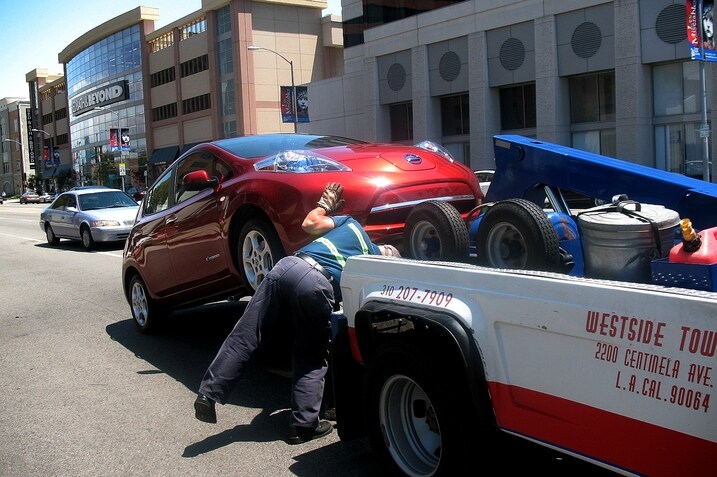
So this is what the Monday after a weekend with the Leaf looked like.
Sigh. Full story after the jump.
Friday evening. The car board comes around, so that the editors can each select a car for the weekend. I sign up for the Leaf — I don't have a lot of driving planned, and figure the quiet weekend will be a good match for the Leaf's limited range.
Anyway, the weekend winds up being more social than I'd anticipated, with the Leaf heaving and stopping through West L.A. and even inching its way into Hollywood's perpetually congested streets. By the time Monday morning yawns and stretches, I've put 53 miles on the Leaf's odometer — almost all of that from city driving. As I'm pulling out of the carport on the way to work, the Leaf's distance-to-empty (DTE) gauge is showing 13 miles.
Thirteen miles. No cause for concern, I reason. After all, I live only seven miles away from the Edmunds nerve center. Should be able to get there with a few miles to spare.
I'm in "Eco" mode, driving like a Pasadena schoolteacher, and I'm almost there. The electric eagle has almost landed when I remember: Hey, on Monday mornings, each editor is expected to lather up the car that he or she borrowed over the weekend. And the Leaf is looking kinda grimy.
The car wash that we typically use is on the way in, between my apartment and the office, about two miles from work. Getting there requires getting off the freeway a couple of exits early and traveling a few blocks north. I guess the detour adds no more than a mile or two to the journey, if that.
By now, the DTE gauge has given up trying to make any predictions — it's thrown its hands up in the air, offering this not-so-helpful estimate: "---". But I've still got one bar of electricity left on the charge gauge. Should I risk it? I decide to go for it.
A few minutes later, the car is freshly washed, glinting in the SoCal sunshine. I start her up, pull out of the car wash, and get the message shown below.
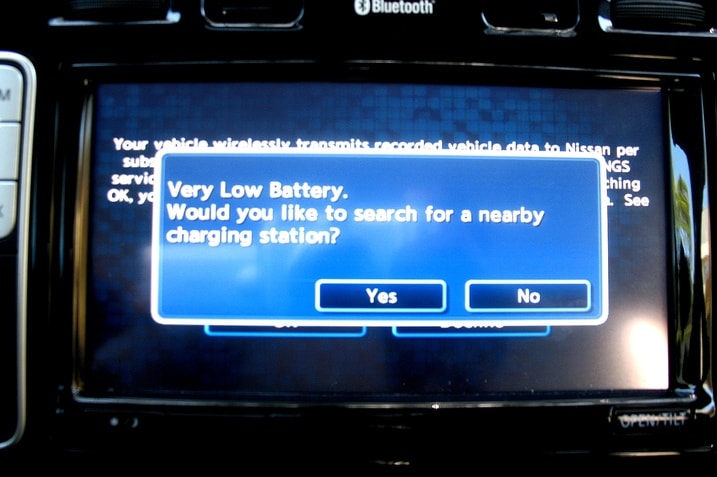
Not very encouraging. But I'm almost there. Our office is only two miles from the car wash — 1.74, to be exact.
A couple moments later, I see it — the flashing tortoise.

No, not the Takahashi-spawned creation shown above — one that's even more terrifying. The one you see in the Leaf when it's about to slash the speed and cut the power. The car slows down.
Things don't look good, but I'm still hopeful — after all, didn't we get about two miles in flashing-tortoise mode in that test we did? I'm in the far-right lane on Olympic with the hazard lights on, coasting whenever I can.
But alas, the flashing tortoise isn't nearly as kind to me as it was to our testing team. After a block or so, the Leaf checks out, at 62.6 miles.
I'm half a block from a major intersection. No nearby spots to push the car into — nothing to do but call AAA and wait.
The motorists behind me are surprisingly courteous, moving 'round the dead Leaf without vitriol. Ironically, the sole exception is an older woman in a Prius, who lays on her horn. What, no green love, lady?
In a matter of minutes, the AAA tow truck arrives. The driver is a major talent — he's able to maneuver the Leaf into the Edmunds parking structure with no drama and even gets it positioned close to the charging pedestal.
In the end, there are no hard feelings and I wind up learning a little bit more about the Leaf. Those gauges aren't an exact science in real-world driving (duh!), so on our next weekend together, a DTE reading of 20 will be my signal to guide the Leaf back to the office, slowly and gently, for a charge.

In most cars, Eco mode is something I avoid like the plague, since as I see it, the improved fuel efficiency just isn't worth the performance sacrifice. A zippy Lexus CT 200h that I once drove got so sluggish in this mode, it felt like I was sloshing through a vat of hot fudge.
Fortunately, though, the Leaf doesn't have this affliction. Shift that odd round shifter down to the Eco setting and responsiveness is dulled, but not to the point where the car's reflexes feel mired in quicksand.
To discourage aggressive inputs, throttle response is softened, but the effect is more subtle than it is in other models. Eco mode also amps up the efficiency of the Leaf's regenerative brakes and cuts back on power sent to the HVAC system. According to Nissan, driving in this mode can improve the car's range by up to 10 percent.
Does your car have an Eco mode? Do you use it pretty often?
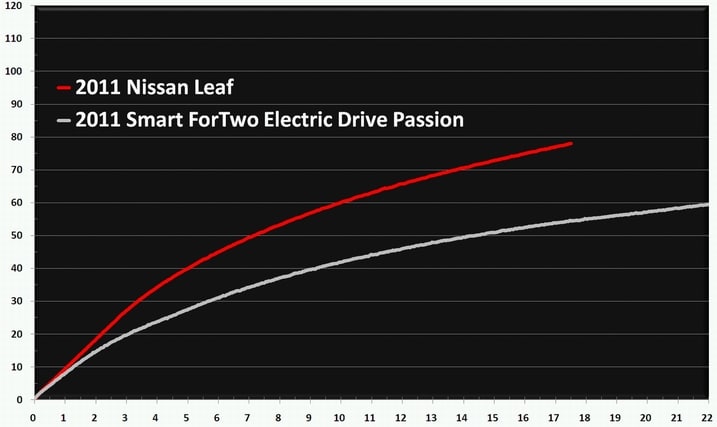
After we track tested the 2011 Smart ForTwo Electric Drive Passion (smallest car with the biggest name), and realized how slow it was, it got me thinking. How would its acceleration curve compare to our long-term Nissan Leaf? It gets smoked by the Leaf.
Leaf track test results:
0-60 = 10.2 seconds
1/4 mile = 17.5 sec. @ 75.9 mph
Smart track test results:
0-60 = 22.4 seconds
1/4 mile = 22.0 sec @ 59.5 mph

At first glance, it would appear that the Nissan leaf has a small trunk, but it actually holds more than you might think. I went to Costco and Target last night, and had plenty of groceries to put it to the test. One item to note is that some of the Leaf's useable trunk space is taken up by its portable charger (black bag on the right). The rear seats can fold down, but your options are limited by the position of the battery, which sticks up pretty high.
With the seats and charger in place, I was able to fit a case of water bottles, a box of trash bags, a 40 pound container of cat litter, three bags of groceries, a big box of chips and 36 rolls of toilet paper.

Nissan has not released the cubic feet measurement for the trunk, but in our formalized testing, the Leaf was able to hold four small pieces of carry-on baggage or one large one.

When I closed the rear hatch, the cargo cover did pop up slightly, but it shut easily. Not all my groceries fit in the trunk (the rest went in the backseats), but I was still impressed with how much the Leaf could hold.
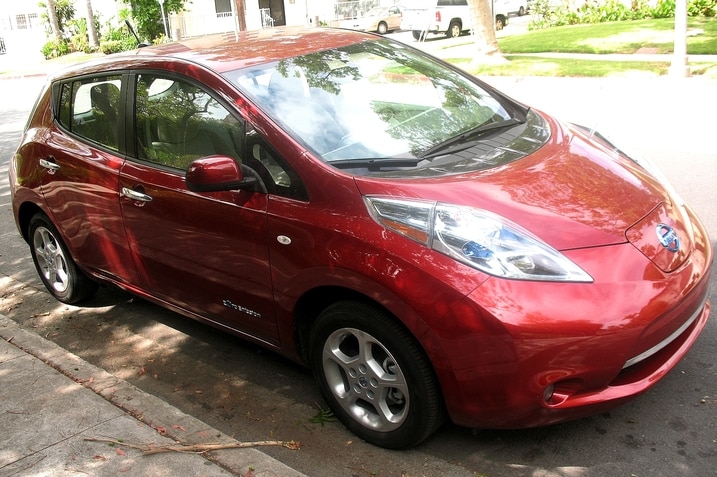
The Leaf bucks the unfortunate trend toward teeny tiny greenhouses (the byproduct of high beltlines) by giving us one that's for the most part, very functional and relatively big. It's only appropriate, really, for a green car to feature a greenhouse that lets the outside in. On sunny days like the ones we've been having, the Leaf's airy cabin makes cruising around town all the more pleasant.
Still, when it comes to green cars with large greenhouses, the Leaf has nothing on this white-hot hunk of automotive sex appeal...

Tasty, right? It's called the EcoV and it's an electric car that can reach speeds of up to 25 mph (making it street legal on roads with 35 mph speed limits, in case you're interested).
Starting price is less than $10 grand, so it can be yours for a song.
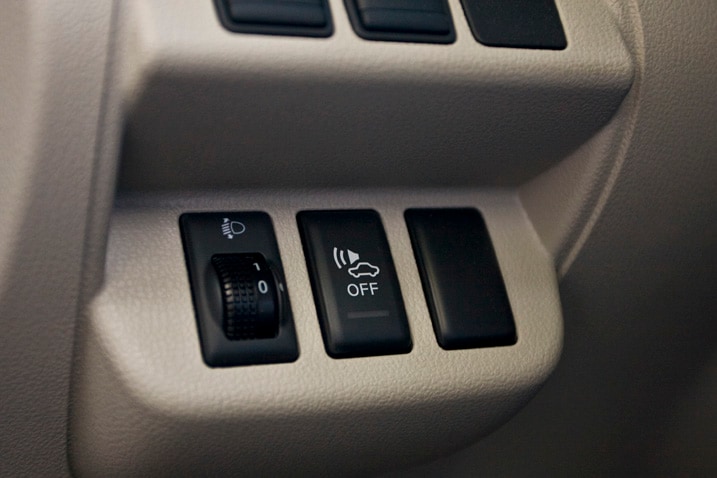
I need to get my head checked. I'm beginning to really like electric vehicles. I'm not saying that I'll give up internal combustion any time soon (you can have my V8 when you pry it from my cold, dead hand), but I can see (and hear) the future — and I like it.
Last night, as I drove down a tree-lined street in my neighborhood, I rolled down the window and heard nothing, and everything. Obviously there was no exhaust rumble, but I was treated to the sounds of the birds chirping and conversations of people on the street. I could still hear the artificial whine that the Nissan broadcasts to warn blind people of its approach, but there's a cancel button for that.
Personally, I like the noise it generates. It's what I thought a 21st-century car would sound like when I was a kid. Coincidentally, I also think it's what Dart Vader's dustbuster would sound like.
I turned off the sound and, wow, a zen-like driving experience. The last time I encountered this was in a Tesla Roadster. Taking a corner, I could hear what each tire was doing. It was as though I gained some sort of extra sensory power. Now all I want is a true electric sports car so I can push this newfound super power further. I also have been mesmerized by the trailer for Charge, a documentary about running electric racebikes at the Isle of Man.
I will always love the roar of a race engine, but the whine of electricity is the future. We'll always have the roar, I suppose, at historic motorsports gatherings. A week ago I would have considered this blasphemy, but I'm eagerly awaiting the arrival of a top-tier all-electric race series.

Top Gear fans in Lincoln, England, got a chance to live the dream and walk among their idols when the Top Gear UK team stopped into town to film an episode. TV hosts Jeremy Clarkson and James May enlisted the help of the townspeople when the 2011 Nissan Leaf they were filming ran out of juice and needed to be pushed near an outlet where it could be charged.
However, it was revealed several days later that TG intentionally drained the Leaf's battery to provide for some typical reality show suspense. Surprise, surprise.

Driving the Leaf is a bizarre experience. Besides the slight whine from the electric engine, this thing is basically silent. It's like floating around on an enclosed magic carpet with a steering wheel. The thing you notice most is the wind noise, which is just weird to me.
After I got over my initial electric drive heebie jeebies, I actually started to relax and enjoy driving this oddity. After another 20 or so miles around town, my initial skepticism faded as the Leaf started to make sense to me as a capable commuter and errand runner. I even liked the airy interior. The center stack reminds me of a tablet.
So what's the deal with the photo?
The image is an Anaglyph. Yes, the 1950's style 3D. You'll need the red and blue glasses to get the 3D effect. I'm experimenting with this kind of image it to show off the clean, light feeling you get inside this futuristic cruiser. If you don't have the glasses, then it's just annoying to look at. Sorry 'bout that.
During my morning dog walk, I bumped into my neighbor from down the street who is an electronics engineer. He was fascinated with the Leaf. He's so into this kind of technology that he regularly attends lectures on the future of alternative fuel vehicles. As I stood there holding a bag of dog poo, he asked me technical questions that were beyond my knowledge. It just made me realize how much thought and engineering went into this car. That or I don't know jack about this car. Probably somewhere in between, trending towards jack.
This was my first real overnight driving experience in our Leaf, and I'm a believer. Nissan was able to combine a massive amount of technology into seemingly effortless package. I'm looking forward to many more days on the road in our Leaf, provided I'm near a charging station.

The Nissan Leaf has porthole windows up in front I'm a fan of the little things. They expand your view of the road which makes them a good idea from a safety perspective. They also add a nice, airy ambiance to the cabin.
The Prius also has porthole windows, in front and in back, so maybe this design cue is a favorite of those who design green cars.
Of course, the downside is that, from an appearance perspective, they don't exactly up the "cool" factor. In fact, I'm guessing that many would probably say these windows look kinda dorky. Like the automotive equivalent of a pocket protector or something.

What do you think? Does your car have porthole windows?

"Oh. My!" exclaimed my wife as I hit the accelerator in our Leaf from a stop light. She was expecting to get a lot more gray hair before arriving at Target. It's not chirping tires or laying patch with it's meats, but this little alt-fuel machine can actually accelerate at a pretty respectable rate. Add to that the fact it rushes forward nearly silent just brings a grin to my face. It's just silly.
We recently tested it at a 10.2 0-60. Not a barn burner, but still pretty good for all electric. To keep things relative, in our testing the Honda Insight got a 10.9 while a Toyota Prius got a 10.1 0-60. Both boosted by gas engines.
The more I drive, the more I like our Leaf.
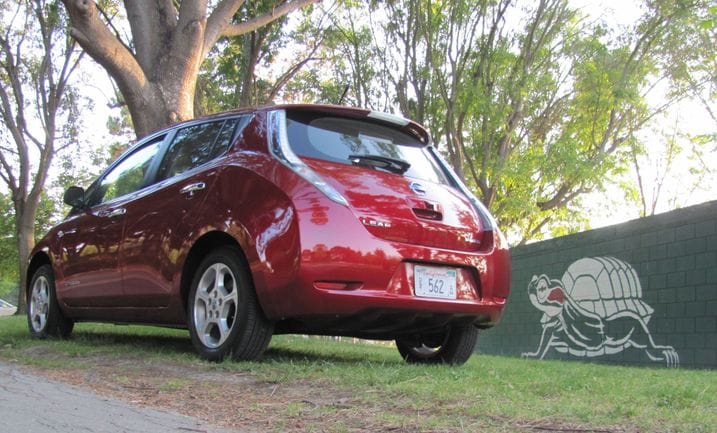
This photo is red meat for EV haters who say that electric cars are slow, dull and nothing more than a flash in the pan. Meanwhile, I'm going to be leasing one this summer so I drive the Edmunds Leaf often to make sure I really want to buy into a new lifestyle.
As Scott Jacobs points out the Leaf isn't really that slow, needing only about 10.2 seconds to get up to 60 mph. But it feels faster since it's quiet, seamless and delivers instant torque.
Meanwhile, I continue to justify my decision by saying the Leaf is the only car (aside from a Honda Civic GX or Tesla) to get me into the carpool lanes. Since the range is greatly improved by driving at speeds from 45 to about 65 mph, I'll leave later to let the carpool lanes load up a bit. Then my 62-mile round trip will leave a little wiggle room for a lunch-hour adventure.
The numbers from my most recent commute are encouraging. I left the office with an indicated 88 miles of range. After traveling 31 miles to my house I had 61 miles of range left. I ran errands after dinner and arrived back in the office this morning after traveling a total of 72.5 miles with 14 miles of range remaining. So the predicted 88 miles was looking like an actual 86 miles of driving.
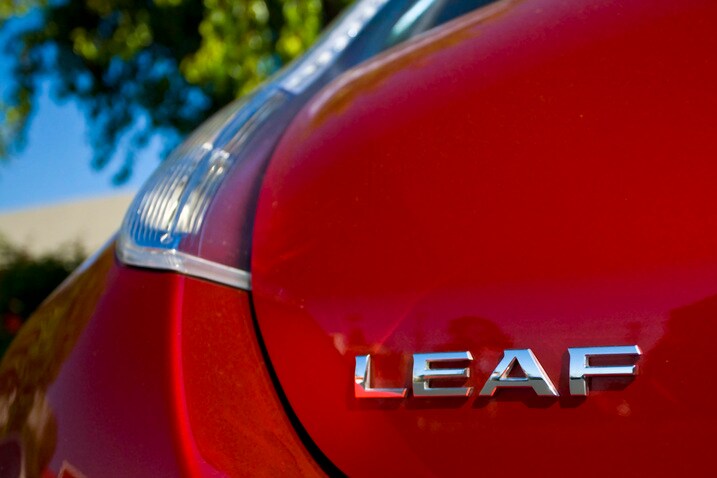
My brother-in-law Steve has been considering purchasing a Leaf. He's serious enough that he put his name down on the wait list a while back and it seems like it's finally his turn. But the Nissan dealers won't allow him to test drive one. When the sign-out clipboard arrived at my desk, I made sure to grab the Leaf and head over to his house.
I asked him to email me some thoughts on the car and also what is going into his decision. He sent me the very insightful response that follows:
Thoughts on going electric:
Though I know switching one ICE for an EV won't solve the problems of climate change, national security, and pollution, electrification of mobility is inevitable and the sooner that happens, the better off we'll be environmentally, financially, and national security-wise. So much has to change before switching makes sense to a lot of people. For some, it's longer driving range or more vehicle types to choose from, and for others it doesn't make sense to trade one fossil fuel - gasoline - for another one to generate the electricity - coal. All these things have to change and are changing. A dozen or more EVs of all types are in development, the next generation of battery and control technologies are already being perfected in labs all over the world, and existing renewable energy sources are being added to the grid at a record pace.
So is it time to make the switch? Certainly the range, performance and selection will improve if I wait another year or two, and by then there's a better chance that plugging into the wall won't cause 24 lbs of coal to be burned to replace 24 lbs of gasoline.* But waiting until the situation is ideal is one way to make sure that time never comes. Which isn't too say that the thousands of Nissan Leafs coming into the nation's fleet aren't doing much to help the environment right now- they are. Even if coal is used to generate electricity for the grid, if the car is charged at night, it's not increasing demand for electricity generation, and chances are in many places, it's probably using electricity generated by wind turbines that do most of their generation at night. And in the worst case scenario, where you plug your Leaf directly into a coal burning power plant, we're still better off because even though the amount of coal burned to power an EV to go 100 miles is equivalent to the amount of gas that would be burned if it were an ICE, we're still saving the other 24 lbs of coal that were already burned to refine the oil into 3.7 gallons of gasoline (not to mention the fuel burned to get the gas to the gas station).
So environmentally, it's time, and society should start making the move, but what about me personally? Am I ready to give up my turbocharged 2.5l Subaru XT (with SPT cold air intake) and it's muscular growl for a silent, smooth, and boring actually, ride? Being driven in the Leaf felt like a ride on the monorail at Disneyland. It's cool but no excitement. It moves and it stops. I think even when you're driving it, you're really just riding in it. It doesn't rev, it doesn't skid - thank god there's still a steering wheel. But, despite all that, it is kind of cool. On this point I'm still undecided.
Aesthetically it's not a look I go for, but after driving any car for a few months, I don't really see it anymore so I don't think that concerns me. I didn't get to play with all the fun electronics but just the idea of being able to play music and audiobooks off my iPhone without taking it out of my pocket makes me very happy. (He's new to Bluetooth streaming -ed.)
Now the deciding factor, money. I'm looking at the SL model with the fast charge option for $34,420. With tax and registration, $37,900. Take out the $7,500 federal tax credit, and the $2,500 California Rebate and I'm at $27,900 all in. If I can get $18k trade-in on my Subaru, I'm in it for just under $10,000 which is about how much I'll save on gas the first 3 years. I know the CA rebate is $5,000, but it's due to run out and they're talking about bringing it back at $2,500.
I think I decided to get it.
*Rough assumptions based on 24kWh to charge a Leaf to go 100 miles, 3.7 g of gas running an ICE at 26 mpg, and 1 lb of coal to generate 1 kWh of electricity.
I posted this pretty much unaltered (makes me feel like someone else did my homework for me). What do you think? Got any advice for him?
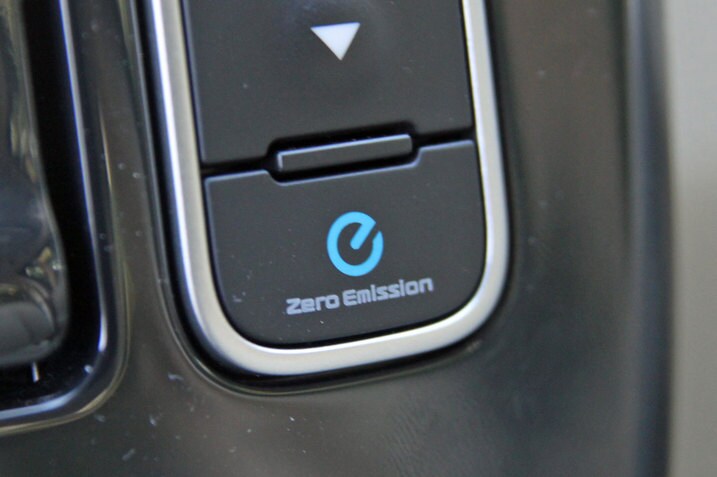
It seems obvious now, but I didn't really know what this button did when I pressed it. I mean, it's already producing zero emissions right? It's not like you can turn it off and make it belch smoke, although I would love it if you could.
So what does the "zero emission" button do?

Turns out it's a single point of contact for all of the Leaf's various "green" functions. You want to find a charging station? Press here. Curious how long it's going to take to charge? This is the place to go.
As you can see, just about anything you would want to know about the Leaf is right here. It's basically like your average trip computer turned up a few notches. Cool if you're into that kind of stuff, out of the way if you're not.
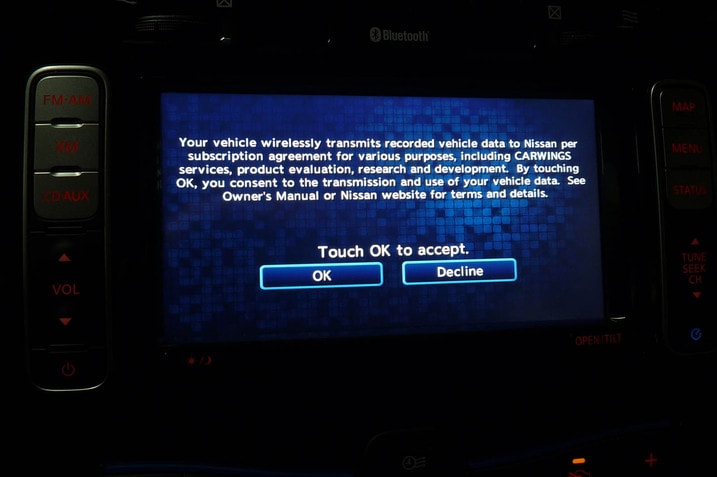
This is the screen that greets you as you start up the 2011 Nissan Leaf. It reads, "Your vehicle wirelessly transmits recorded vehicle data to Nissan per subscription agreement for various purposes, including CARWINGS services, product evaluation, research and development. By touching OK, you consent to the transmission and use of your vehicle data. See Owner's Manual or Nissan website for terms and details."
Here's the EV project agreement and here's the Leaf's owner's manual, specific information is on page 339, section 9 - 16.
So, the question, do you care that your car is sending information about you wirelessly to the manufacturer?
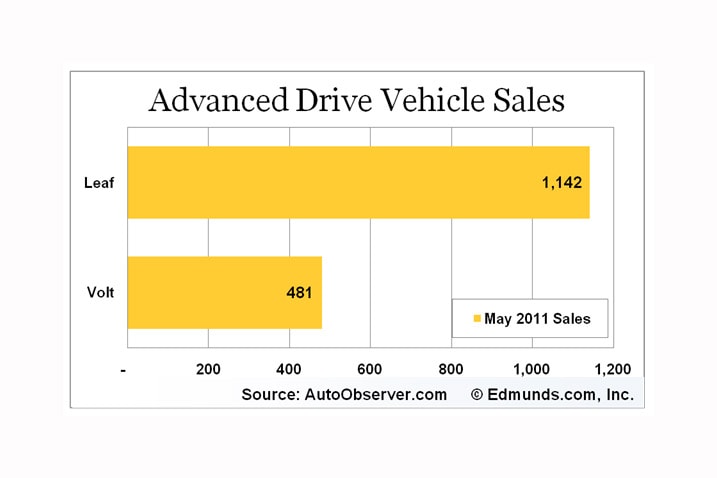
Sales of the Nissan Leaf have nearly doubled for the month of May at 1,142. Last month they sold 573 units. By comparison the Chevrolet Volt sold 481 units in May.
See the Nissan teaser ad for the Leaf which shows an alternate reality of all gas-powered appliances. The ad takes a shot at the Chevy Volt and even shows it filling up at a gas pump. The ad doesn't, however, show the two cars driving side by side to see which car can go farthest.

What you see above is the badge on our Leaf. No, the color balance is not out of whack on my camera, the badge is actually tinted blue. Blue? Why blue? I have to admit, I'm not a fan of the blue treatment. To me, it looks like somebody left the protective film on it — the film that keeps shiny bits from getting scratched up in transit.
As a former designer, this is a minor annoyance. I get the whole "blue skies" association, but for me, green is where it's at. If it were up to me, I would've proposed something as subtle as green lettering.
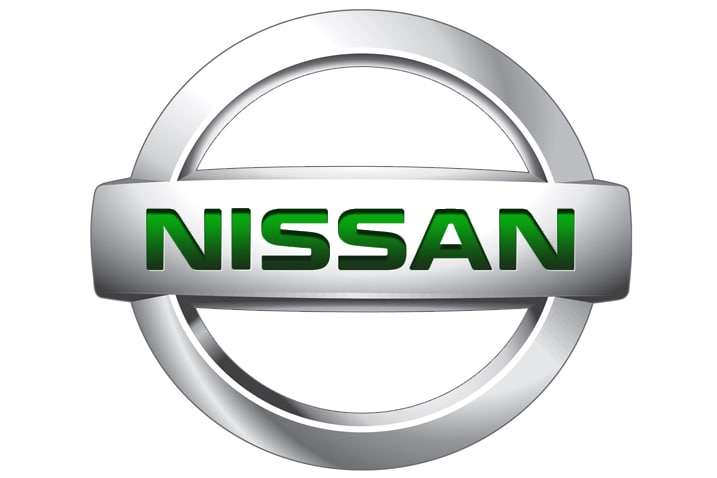
Lexus uses blue inserts on their hybrids and it seems to work just fine. Here's the Nissan logo with green inserts added. I think it's a bit too much.
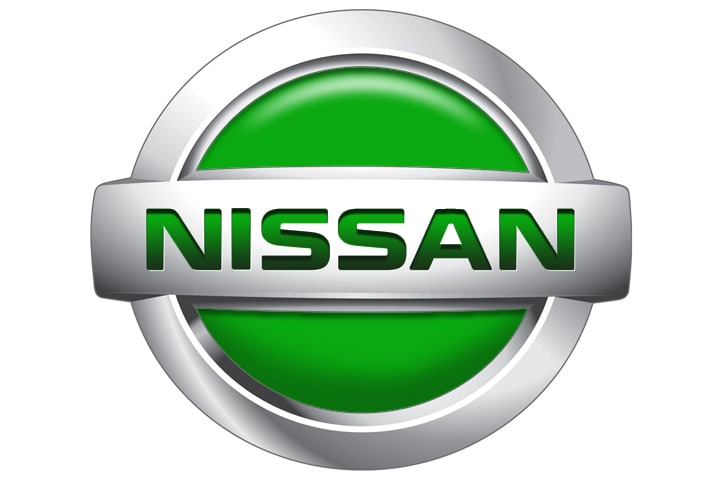
Since I thought I had already gone too far, I decided to push it even more. Maybe some nice glittery leaves. To my surprise, I quite liked it.

What do you think?

What if everything used in your day-to-day living was powered by gasoline?
In an attempt to have us re-think the internal combustion-engined vehicle, Nissan USA generated such a world in this creative video ad.
The ad even includes a dig at the sometimes gasoline-powered Chevy Volt.
Check out the video on the jump.
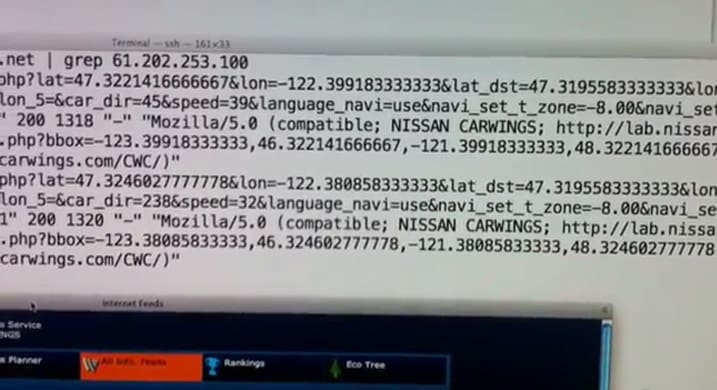
A few weeks back, we got into a quick discussion about the Carwings warning screen on our Nissan Leaf. The warning says that, should you press OK, your Leaf will wirelessly transmit recorded vehicle data for various purposes "including CARWINGS services, product evaluation, research and development."
But would you expect it to send things like your speed, GPS location, destination etc are passed directly to each RSS feed you're subscribed to? (For those who aren't aware, you can subscribe to RSS feeds via Carwings and your Leaf will read them.)
It seems unlikely that your RSS feeds want anything to do with this information, but still, not sure I want it being sent out everywhere. So again, I'll ask: Does this bother you?
(Allcartech via Slashdot )

The cost of the 2011 Nissan Leaf is complicated by many factors that subtract and add to the purchase price. One cost, the home charging station, is frequently quoted as being $2,000 for the purchase and installation. I'm getting ready to receive my own personal Leaf so I got an electrician to come look at my wiring system.
The electrician was a hip, young dude who's owned the Toyota RAV4 EV for years. After looking over my electrical panel he said, "You know, there's another option which could save you a ton of dough." Save money? Okay, I'm listening.
"You don't really need a home charging station," he said. "You just need a 240 volt connection and then you can modify the cord that comes with it to charge at the higher voltage." And how much is that? He said he would replace my old, corroded circuit breaker system and install an external 240 volt outlet for $900 parts, permit and labor. (Installing just the 240 outlet would be much cheaper.) My only other expense is $239 to modify the cord included with my car so I can charge from the outlet at 240 volts.
Last night, I took the Edmunds.com Leaf home and plugged it in on the 110 volt connector inside my new box (our cord isn't modified to use the 240 plug). In the morning, the Leaf was completely recharged and showed a 104-mile range. This dropped quickly, of course, but when I got to the office, after covering 32 miles, I still had an indicated range of 62 miles.
The electrician said he frequently goes to visit his parents in his RAV4 EV and their house is outside his comfortable round-trip range. To solve this problem, he installed a 240 volt charging outlet at their house. His car is charging as he visits with his folks. A nice solution that essentially boosts the range of his EV.
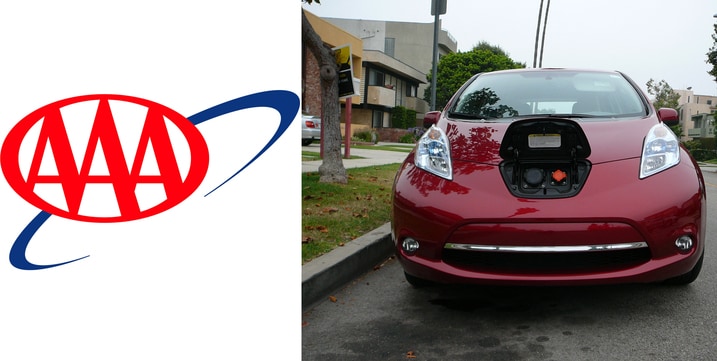
Edmunds Auto Observer is reporting that the American Automobile Association (AAA) will be offering mobile charging for EVs that run out of juice.
Details are limited at the moment, but Auto Observer speculates that the charging will most likely use the faster Level 3 chargers. Level 2 chargers, which require eight hours for a full charge, would not be a practical solution.
Not all EVs and not all Leafs have a plug to accommodate a Level 3 charger. The "Quick Charge Port" (left plug in the photo above) is a $700 option only available on the Leaf's higher SL trim level. A 30-minute charge from the 500-volt quick charger can bring the battery to within 80 percent of a full battery.
The AAA program is scheduled to launch later this summer in a few select cities. We're hoping Los Angeles is one of them, just in case we have another incident like this. A 30-minute charge would have given us plenty of battery power to get back to the office and avoided the hassle of having the car towed.
Would you be more willing to purchase an electric car if more of these AAA trucks were out there? Would it help alleviate your range anxiety?
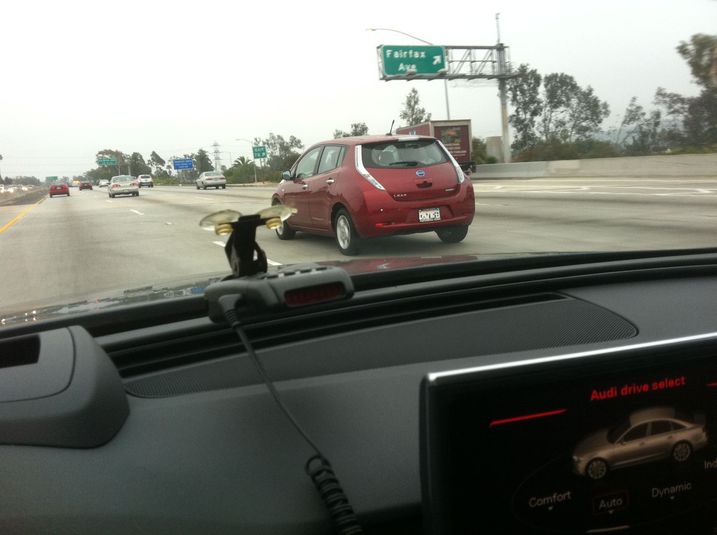
I spotted this Nissan Leaf in its urban habitat yesterday: the I-10 freeway in Los Angeles.
And it was the same ugly Merlot color as our long-term tester. (I prefer the light blue or white — which of course makes up every other car in our test fleet.)
It didn't have any special tags (e.g., government or carmaker), so perhaps it was owned by an ordinary citizen just trying to reduce his carbon footprint.
'Good on ya' pal/madam.

This weekend was the 89th running of the Pikes Peak International Hill Climb and, for the first time, a series-production electric vehicle made the climb. And behind the wheel was none other than our very own Scott Doggett. Unfortunately our long termer couldn't make the trip to Colorado Springs, but Nissan had one at the ready.

Besides having a quiet-as-a-crypt cabin and no exhaust fumes, our little Leaf has a decent amount of power. Case in point: this morning's drive into the office and a sneaky driver.
There I was at a red light, waiting patiently for the light to turn. Then I see a white Mazda 3 sneaking up on the right. With that ridiculous grin on the front of that car, I knew that this driver would attempt to snake me out of the gate. There's no real lane to the right of me, and there's very little room ahead for the Mazda to accelerate and pass. There's no doubt that she is going to swerve right across my bow.
"None shall pass," I said in my best Black Knight voice, "I yield to no Mazda."
Sure enough, as the opposing traffic light turned yellow, the Mazda 3 started creeping forward out of my blind spot. A quick flick of the drive selector from ECO to D, a hearty stomp on the pedal and I was smoothly and quickly shuttled far ahead of the right-lane demon.
"I'm invincible! The Black Knight always triumphs!"
But like John Cleese's character in one of my all-time favorite movies, I was probably a bit misguided. The Mazda driver probably thought that I was unaware of her presence, or that as an electric pod person, I didn't have the stones to blow through a bunch of electrons in order to reach the other side of the intersection first. Or perhaps she underestimated the Leaf's instant torque.
In any case, I won. So, "na-nana-boo-boo, stick your head in doo doo."

This was my first time driving the Nissan Leaf. I'm not sure what took me so long to try it. I liked our electric Mini E very much but for some reason I've been avoiding the Leaf and the Chevy Volt.
Driving the Leaf is very similar to driving the Mini E. Full torque as you put your foot down. The same whirring noise. The range per charge is similar at 100 miles. The regenerative braking is less aggressive in feel but it recoups a lot of power on the fly.
At first I was a little concerned. When I got into the Leaf the range stated 100 miles. Before I even pulled out of our lot it was at 98. And by the time I exited our parking garage and stopped at the red light on our corner, I was down to 93. But as soon as I got on the freeway and was coasting along at around 45 mph in mild traffic, I started to gain back estimated range. At one point I was almost near my exit and the range meter read 101 miles. I thought I might make it home with more than I started. But as soon as I got into stop-and-go traffic, the range started dropping. By the time I got home (total trip 20.5 miles) the range meter read 83.
The Leaf had plenty of juice enough for me to drive home, drive to dinner last night, run some errands this morning, and get me back to the office with about half its charge left.
I'm not crazy about the Leaf's interior. It's pleasant enough but I wish Nissan had designed it to be more normal looking. The Mini E looked just like a regular Mini Cooper except for the lack of a back seat. But it had pretty much the same gauges. Nissan seemed to go the Toyota Prius route with the Leaf. It has a special little shifter and a layered dash that feels miles away. I'd rather it look and feel like a normal car.
I had to consult the manual to figure out some of the cryptic icons. Some of them seem repetitive. I was concerned about a red triangle warning light. But it was just telling me that the parking brake was set. There is also a parking brake light. Plus, there's the range meter, the power meter, and in the top section of the dash another meter that calculates your usage on the fly. Seems like overkill.
All in all, I liked driving the Nissan Leaf. I would have signed it out for the weekend but it's a holiday and who knows how far I might want to go.
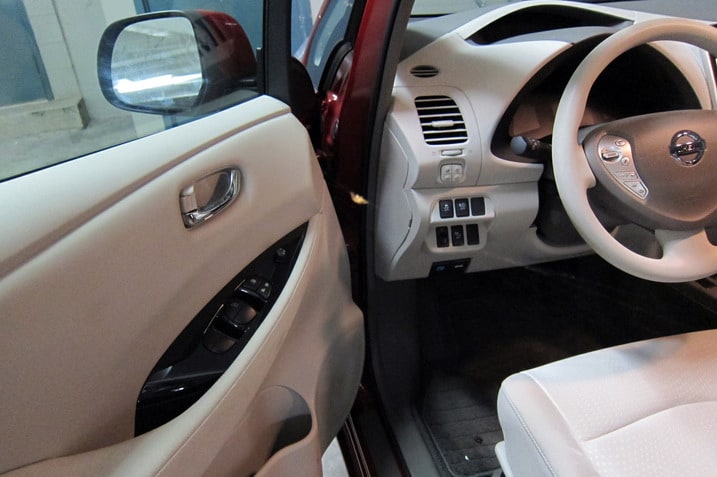
Look right in the center of the above picture and you'll see what greeted me when I opened the door to the Leaf last night.
Spidey was in the wrong place at the wrong time.


You'll certainly recognize our 2011 Nissn Leaf SL above. The strange man making a move on her, however, requires a little more explanation. His name is Jeff Jaikumar and we met him on the internet. More specifically, we met him on Twitter when we asked, as we've done a few times now, "who wants to drive one of our test cars?"
Jeff tweeted back, said he's local and would love to spend some time in an electric car and that was that. What follows is his story....
The Nissan Leaf — A cure for the caroholic?
Hello, my name is Jeffery Jaikumar and I am a caroholic. What is that you ask? I love cars, maybe a little more than I should. For instance, when I see friends, I ask them about their families, life, school, and then their car. A friend may ask me what I think about a particular car, and I end up telling him or her about 10 other cars. So why do I think the Nissan Leaf may be a cure? Well, it's not exactly a car that makes us caroholic's giddy with joy about its crazy horsepower specs or unbelievable 0-60 times, or its 0-100-0 time. Actually, it is a car that we fear. If this car catches on, what happens to the driving experience? I can't rev an electric motor up at the light. I can't put in a new exhaust system or air filter for more power. Now I have to learn how to code? Or use resistors and capacitors to get more horsepower? This may be the car for the stereo junkies, but will this car cure my caroholism?
Well, being the gearhead/caroholic that I am, here are some numbers. The engine, err, motor is an 80kW AC synchronous motor. Translated, that's about 110 horsepower out of a 0 liter motor. That's amazing! And torque is rated at 210 everywhere, even at 0 RPM. How, I don't know but it's there. Although I think a dyno is in order to see if that is really the case.
I was invited by Edmunds through Twitter to test drive the Nissan Leaf in Santa Monica, CA. Being the caroholic that I am, I jumped at the chance. Later, I found out that readers were also invited to drive the BMW 1 Series M Coupe, Fiat 500, and Lexus LFA on previous occasions. Perhaps I should have waited. Oh well, I was excited because this was a chance to drive the future and I wanted to see what it was like.
Mike Magrath was the writer who conducted the interview and rode along. When we walked up to the car, the first thing that caught my attention was the color. It was red. I was expecting the light blue color so common in the commercials for the Leaf. The car looked good. It looked like a car and not some futuristic machine that is driven by a robot. The rear had a futuristic look to it with the taillights that swooped down from near the roofline to just above the bumper and the lights were LEDs, of course. There was a small solar panel that apparently reduces any losses in the battery as the car sits parked as long as there is sunlight. It does not charge the car. As I walked around the car towards the front I noticed the headlights and they too had a futuristic feel to them. Beyond that, the car looked very similar to the Nissan Versa, which I don't think is a bad thing. This car is practical. It has a hatch back body style and 4 doors. There was plenty of room for the 3 of us (Scott Skurnik joined, too) 4 should be comfortable. 5 may be a little tight. The trunk was fairly roomy, however I don't think it has a flat surface for cargo and I am not sure if the seats fold down. (They do. -mm) Mike then showed me the charging port which is under a large flap on the front of the car. SAE has set a standard for the charging plug which the Nissan Leaf and Chevrolet Volt use. I unplugged the car from the wall, and we headed out. I like the idea of "refueling" at home. Bye bye gas station or petrol bunker for some of you.
When you sit in the driver seat of a Nissan Leaf, it feels exactly like any other car would on the road. GASP! You would think that this car would have a joystick controller and 3D glasses for the crazy 3-D display and an augmented reality windscreen showing you the weather report and the latest twitter posts. However, there is a steering wheel, a gas, actually, go pedal and a brake pedal. The gear shift lever does have a bit of game controller feel to it, though I think it's connected to the transmission through a wire and computer, and not an actually cable or rod like a manual transmission or older automatics. It was intimidating at first but after a quick look at the picture of how it works, it was very easy to use. It was especially easy to switch between ECO and DRIVE mode. I actually liked how it was designed. There is also a touch screen display that controls the radio and also gives you really good information about the energy use of the car. As opposed to gas powered vehicles, electricity is the only power source in the Leaf, not only for the radio and air conditioner, but for the motor too. The touch screen allowed us to see in real time our energy use of the motor and the air conditioning system. This helped us maximize our range.
Technology is a big part of this car and it shows throughout. There are no dials, just digital readouts. The speedometer is easy to ready. I had some trouble seeing the dash because of the steering wheel, but I think part of the problem was that I didn't know what all the readouts were on the dash. After the test drive, I felt much more comfortable.
So how does it drive? Well, I think it drives very well actually. I was expecting a very disconnected feel and more of a game controller type of experience, or something like piloting a hot air balloon, you just go where the wind takes you. The fact is, the car felt very good. The brakes were firm and effective. There is some regeneration going on with the motor which can feel like you are braking when it is actually the motor but I never felt it unnatural. I think it is because my BMW can feel like that because of the engine braking I get from it. The steering felt really good too. It is light and perhaps not the best for a track day, but that's not what this car is for. For a nice relaxed drive to take care of an errand or fight through traffic to work, the steering wheel is excellent. The turning radius was really good too, as we experienced when avoiding traffic on PCH.
The accelerator is interesting in the Leaf. There are 2 modes that the car can be in, DRIVE and ECO. I started the test in DRIVE mode. In this mode, the accelerator worked as expected. The more that I pushed on it, the more power I felt from the motor. Mike then suggested I switch to ECO mode. In doing so the car took a very relaxed approach to motoring. When accelerating from a light, the car did not jump of the line or feel jerky, instead it was very smooth and calm as it steadily moved from a stop. And the effectiveness of the accelerator pedal was changed. I noticed that I could give it more "gas" but it would not translate instantly into more acceleration or power from the motor. At first, this was unnerving, especially when leaving a light. I felt that I was holding up my fellow commuters behind me. But as I continued to drive in ECO mode, I became more relaxed and actually enjoyed the drive, even though we were driving through Santa Monica and traffic was starting to build up. After a little while, I forgot that I was in ECO mode. When I did switch back to drive, the Leaf suddenly felt very alive and alert. It almost felt like a sport mode. I managed to get a little bit of wheel spin when turning right and pressing the go pedal to the floor. The rush of torque reminded me of my 2002 GTI 1.8t. The torque kicks in early and gives a nice feel of power. I think that in normal driving, ECO mode is the way to go and Drive should be used when more power is needed or wanted.
There is a little display next to the speedometer. It is a graphic that tells you how economically you are driving. At first it didn't make sense to me but as we went along, I noticed that it formed a tree. Mike then said that I was actually way off from being economical. Apparently, 5 trees can be grown. I managed to get 2 in the hour I drove the Leaf. Not too bad.
The Nissan Leaf is a very relaxing car to drive. And it's very easy to drive. There is just a little bit of a learning curve in terms of understanding the controls but it drives like any other economy car on the road with one huge advantage, it doesn't use a drop of gas. I would definitely own one of these if I had my own house. But it would not be my primary car. It would be my commuter car or secondary car. It's a great car for short trips and to get to work and back as long as work is around 40 miles away or less.
After driving the Nissan Leaf for just over an hour, I no longer fear the future. Sure I won't be able to hear the sound of an engine revving over 7000 RPM or the sound of the exhaust as I get off the gas and try to rev match for the next turn. But what I gain is a new type of power. One that is instant, and quiet and smooth. The idea for the electric is not to wipe out the gasoline powered cars but to reduce the frantic pace in which we are using oil. If we all were able to use an electric car to commute, I think our drives would be much more relaxed especially if the drive was in a Nissan Leaf.
My name is Jeffery Jaikumar, and I am still a caroholic.
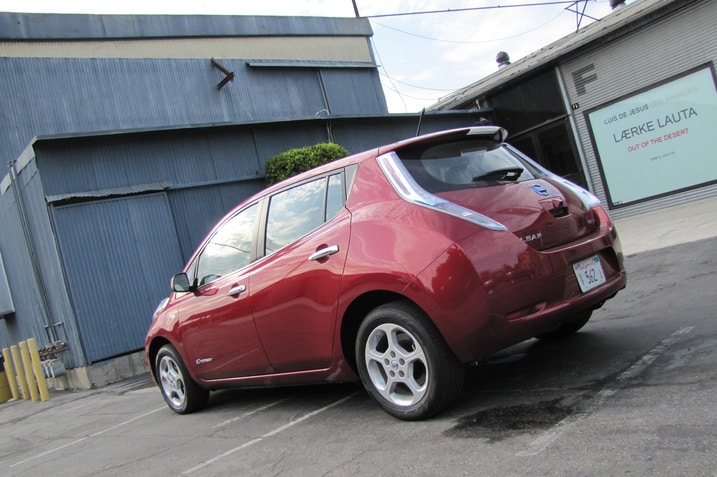
The Nissan Leaf, it sure is weird. Join me now for a visual tour of its weirdness.

Yep, these are headlights and not a crystalline growth within the Fortress of Solitude.
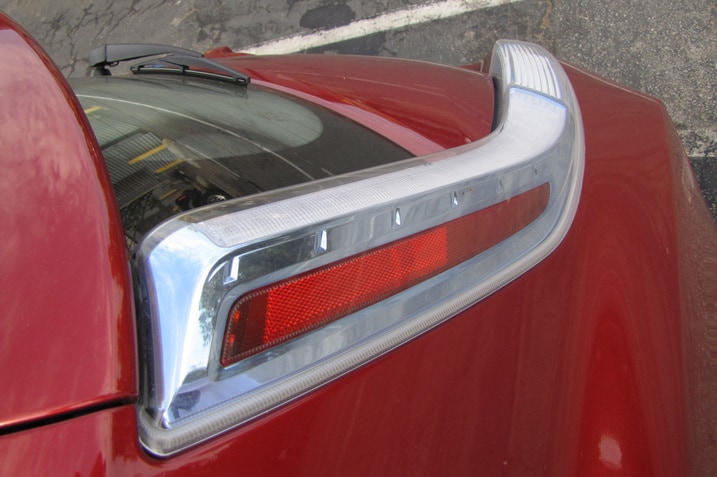
These are the taillights ... not a boomerang from the Fortress of Solitude.
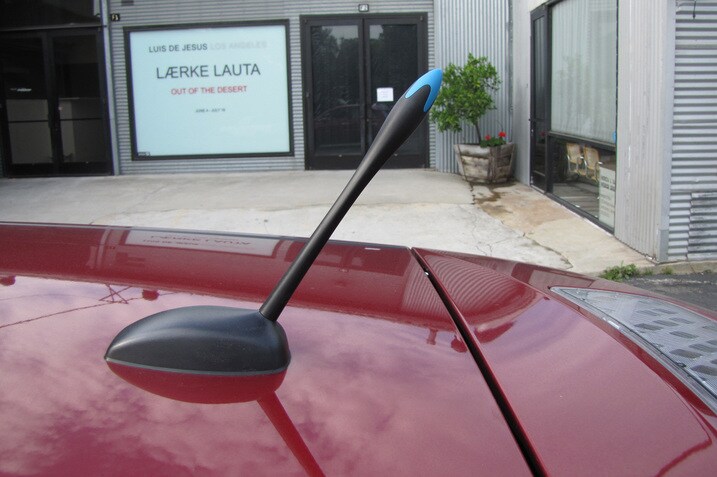
The antenna has a blue tip. Okey dokey.

The Leaf has a rear diffuser.
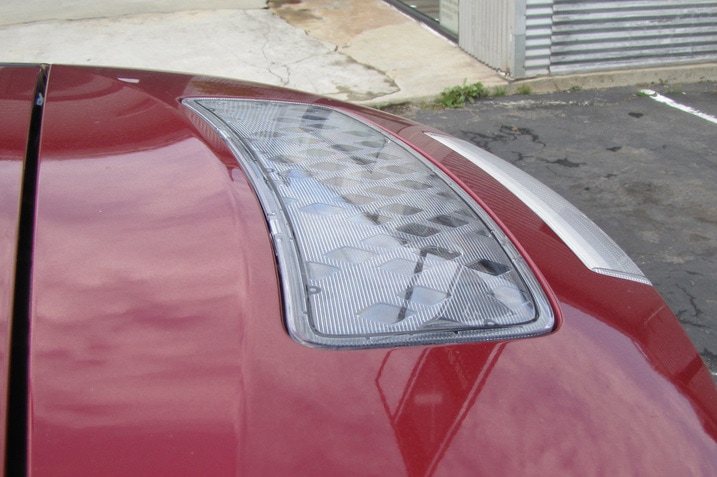
The Leaf's spoiler has a solar panel on it. Image how much juice could be produced if they slapped one of these on an Evo.
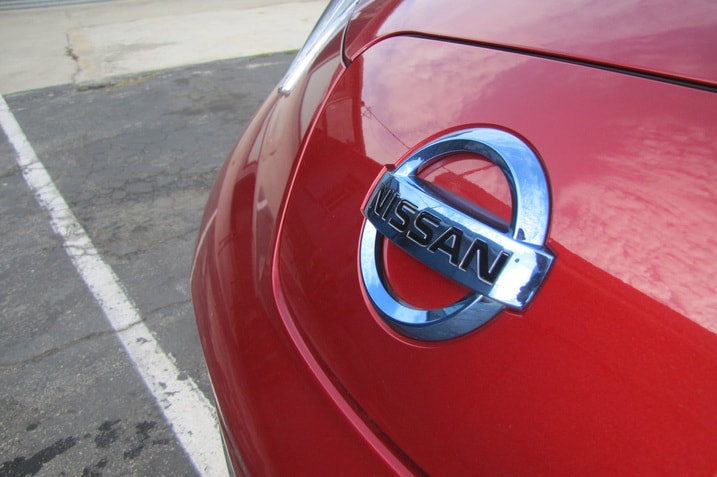
No, they didn't leave the protective plastic covering on the logo. It's actually blue.

Finally, the Leaf is most weird for what it lacks: a door that allows you to pour flammable liquid into it.
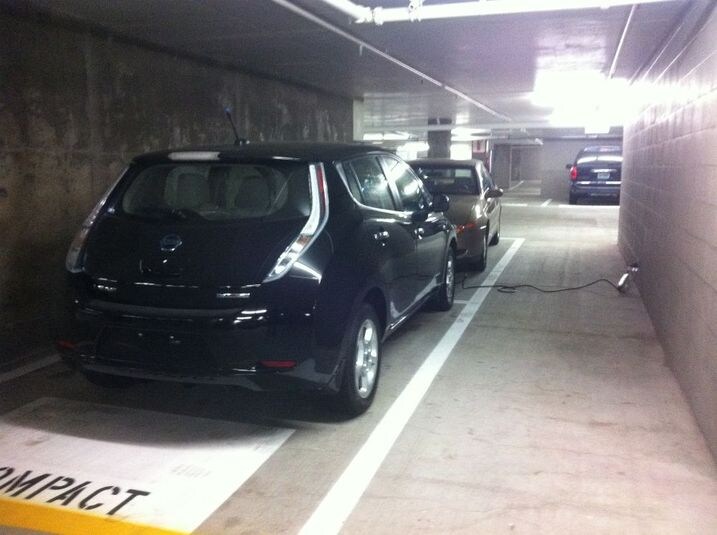
I spotted this new Nissan Leaf in the Santa Monica parking garage of our office getting nourishment from the wall. That outlet is 110V so it would take 21 hours to charge the car to full from empty. I hope the owner either lives close by or the battery was only partially depleted.
In any event, although he must have arrived early to snag a space near an outlet, this guy was able to make the Leaf work as his daily commuter.
So in your face EV naysayers!
And although I usually like most cars in black, the Leaf ain't one of them.

Our Nissan Leaf has a special little shifter that screams "I'm an Electric Car."
I don't agree with the push-forward-for-reverse, pull-back-for-drive action of the shifter. Wouldn't it make more sense to pull backward when you want to go backward and push forward when you want to move forward?
Anyway, Here is a video showing you the shifter in action. When you put it in reverse, a pretty chime sounds to warn people that there is a quiet electric car on the move.

When it comes to environmental-reporting cred, it's hard to beat my friend Marla Cone. She's the editor of Environmental Health News and a two-time winner of the Scripps Howard Meeman Award for environmental reporting. She was senior environmental reporter for the Los Angeles Times and at one time covered the California Air Resources Board, which in 1990 adopted the world's toughest automobile-emissions standards. In 1992, she wrote a fascinating article for the Los Angeles Times Sunday magazine, giving readers a behind-the-scenes look at GM's development of the Impact, the predecessor to the doomed EV1.
Marla and I are auto-twins: We each have a 2001 Acura TL, same options, same color. We both love the car, and love not having car payments.
When I had our Leaf for the first time last night, I asked Marla if she'd take a drive with me and share her impressions of the car. I figured if anyone was going to flip for the Leaf, it would be Marla.
She liked its looks, its interior space, its amenities and its quiet. She said nubbin of a shifter was "a little weird" (I think so, too). We tallied up her daily driving miles and decided the car's range would work for her. We ran the numbers and decided that at $28,000 (after federal tax credit), the price could be right.
But to my surprise, she wasn't flipping.
For some very good reasons, the Leaf is a flop for her — for now. Marla explained why she wouldn't seriously consider an electric car at this point, even knowing the environmental benefits:
"First is probably my reluctance to try technology that hasn't been around long," she said in an e-mail today. "I wasn't exactly speedy in buying a cell phone, laptop, iPod, iPhone. I still don't have an iPad. I'm the type to make sure it works and let companies work out the bugs and hear people's opinions on something before I make the leap with an important item like a car.
"Second is comfort factor with the brand I have used now for 10 years. Cars are something I don't understand well, so the comfort factor is important for me, maybe even trumping environmental factors."
Researcher that she is, Marla used the EPA's comparo tool and ran the numbers for the 2011 Acura TL versus the 2001 that we each own. The 2001 Acura TL puts out 11.74 pounds of smog-forming emissions per year. The 2011 Acura TL puts out 4.13 pounds — an argument for an Acura-to-Acura swap if ever I saw one. She threw in the 2011 Toyota Prius to have a hybrid comparison in the mix. It emits .99 pounds.
The Leaf has zero pounds of emissions, of course. But Marla already has decided that early EV adoption is not for her. She's a couple years away from a new-car purchase, and maybe she'll have more evidence to apply to her decision by then. But I can see what she's weighing right now, and it makes a lot of sense to me. There are considerations for the environment, but there are also the considerations of a real-world driver who isn't convinced that the technology that's on the road right now meets her needs.

Finally drove the Leaf and was quite impressed, like others staffers, mostly by the car's natural driving demeanor. Even in Eco mode, the Leaf's regenerative braking is not overt, unlike the Mini E we had. In that electric Mini you could drive the car at great lengths without ever touching the brake pedal (except of course for quicker stops), so strong was its re-gen braking when you lifted your foot off the umm, "gas" pedal.
Nor does the Leaf's instrument panel hit you over the head with flamboyant, distracting displays. Yes it does have the "Make a small forest" game/function to show how efficiently you're driving, but that's actually kind of cool. But I was surprised to see this cutting edge car lacking synchronized clocks. I noticed an eight minute discrepancy between the instrument panel and center stack monitor displays. My OCD wouldn't allow this so I grabbed the manual and reset the instrument clock (which was fast by my cell phone and PC clocks).
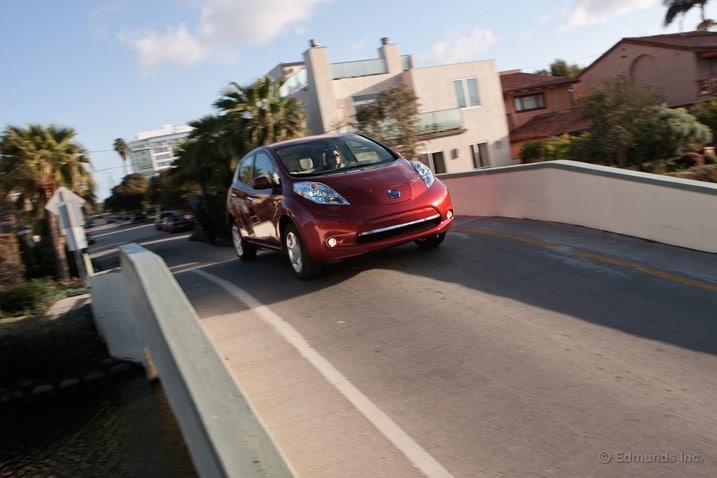
Going the opposite way of the Chevy Volt, Nissan has announced that for the 2012 model year, the Nissan Leaf will come with more options and a higher price.
The Base SV now starts at $36,050, $2,420 over 2011 while the top-trim SL (which we have) will now start at $38,100, $3,530 over 2011.
The price cut for the Volt was due to decontenting and the price hike for the Leaf is due to content addition. Specifically, quick charging, battery warmer, heated steering wheel and heated front and rear seats are now standard. DC Fast Charge is now standard on the SL — something 90 percent of Leaf buyers were already buying.
More expensive, yes, but still $4,000 less than a Volt.
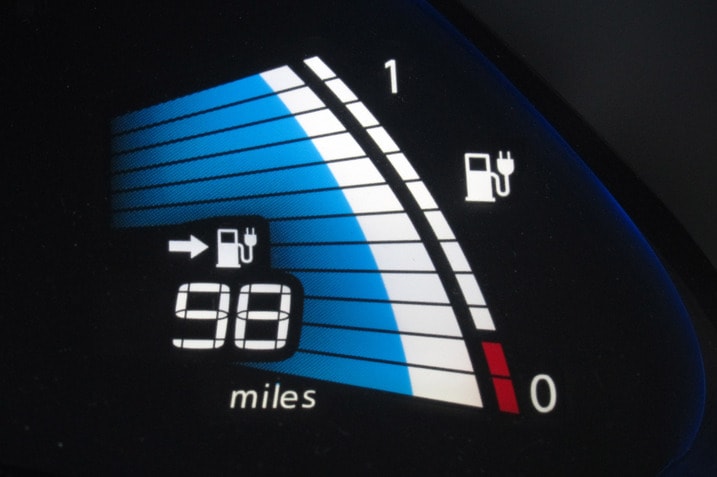
I like this icon that Nissan came up with to represent "fuel" in the electric Leaf. They took the classic gas pump image, which is a familiar icon to all drivers, and added a plug hanging off the side. Very clear. You know immediately what this icon means.
In the picture below you can see the Mini E had an image of a battery for its icon. I like the Leaf's better, although the Mini E's took up a lot less space. What do you think?
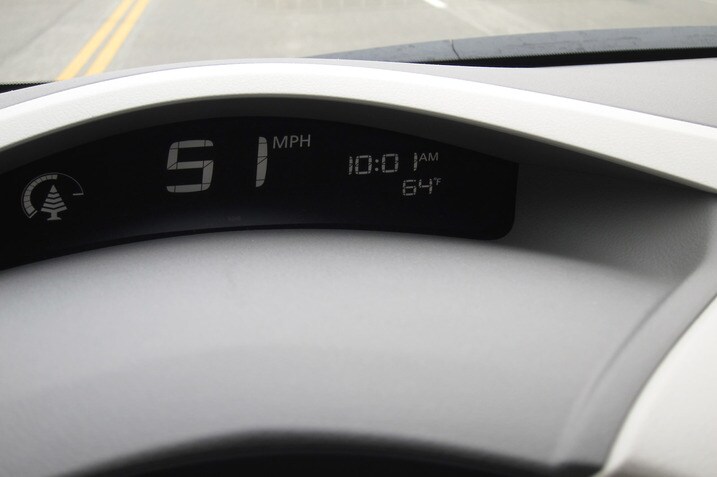
Electric cars are different. No news there, right? You get a satisfying whoosh when you put your foot on the accelerator. Instant takeoff. But I find when I am moving along, I have no sense of how fast I am going.
Sometimes, I glance down at the speedometer and am surprised at the number I see. Because there are no gears to advance through, I don't get a feel for the increase in mph. The crescendo is smooth.
Have any of you driven an electric car?
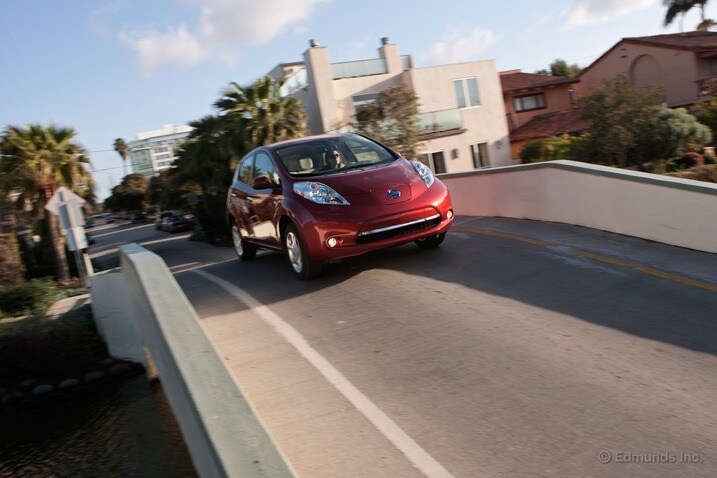
Nissan has stated that the price increase of the 2012 Nissan Leaf is due to additional standard equipment such as a cold-weather package and an on-board rapid charging system.
But the equipment price increases may be more than meets the eyes.
Read this analysis by Senior Editor John O'Dell of Edmunds' AutoObserver.

Warning: Headline only applies to parking in Santa Monica.
Actually, it could apply in other municipalities, but I'm not familiar with the parking laws anywhere else. In Santa Monica, electric cars get free parking at any city meter. Actually, any car with a "Clean Vehicle Sticker" is afforded the same free pass but they're not handing those out anymore.
Who knows how long this little perk will last. At some point, a city official is going to add up the money being lost on free electric car parking and want that back in his/her budget. It's going to take awhile before that number is anything more than a few hundred bucks, though, so until then the Leaf has one more thing going for it.
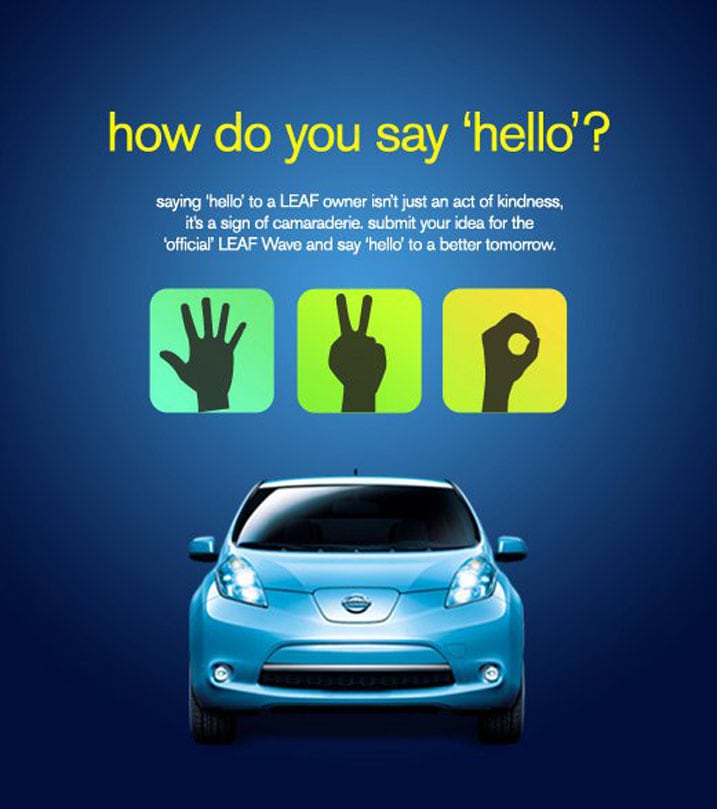
Nissan Leaf's Facebook is asking its fans to come up with a greeting that Leaf drivers (or EV drivers in general) can do when encountering one another on the road. You know, how Evo drivers, Vette drivers and the like say "Hi" to each other.
The peace sign seems to be a popular suggestion with the fans, right up there with the standard honking and waving, but I bet you guys would come up with funner/funny options. I like the idea of equipping Leafs with a green rubber thumb for just such occasions.

There I was, parked in our 2011 Nissan Leaf when this duo walked past. It was all I could do to find my camera in time. Awesome. Thanks clownguy, you made my day.

Nissan Leaf - 1
Toyota Prius - 0
For several years the yellow clean air stickers allowed California drivers access to the HOV-carpool lane regardless of headcount. Under this program the first 85,000 applicants with qualifying hybrid vehicles received the yellow hall pass. The Prius ruled the roadways until the stickers expired at the beginning of this month. When the plague of hypermiling Prius drivers merged into the general population, the HOV lane was free.
Single-occupant vehicles now need these white clean air stickers for the carpool lane privilege. Qualifying vehicles include hydrogen, natural gas and fuel-cell electric powered vehicles. The program lasts into 2015. We patiently waited for our stickers to arrive for the Leaf. Now that they're here we plan to utilize the coveted, vacated carpool lane as much as possible.
I've added over 250 HOV-lane miles on our Leaf in the past 3 days already. Doing so shaved roughly 30 minutes a day from my commute. I can get used to this.
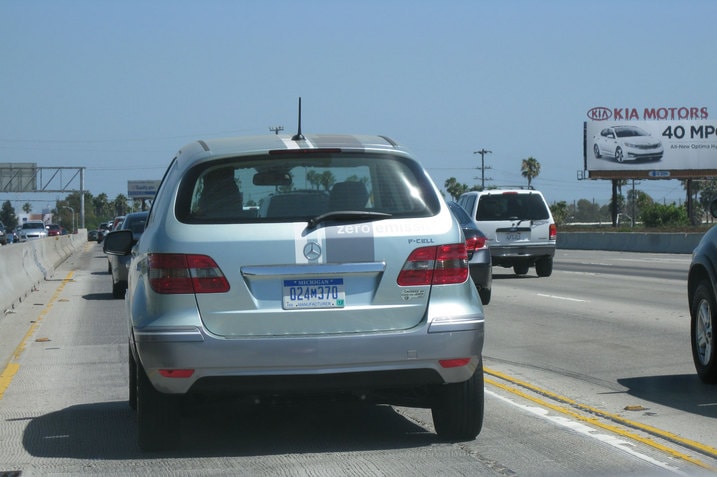
I saw this from the cockpit of our 2011 Nissan Leaf yesterday. I had to wait for traffic to reach a stop before catching this picture. It's the Mercedes-Benz B-Class F-Cell. Initially, these hydrogen-electrics were available through a California-only lease program. This one appears to be a development unit.
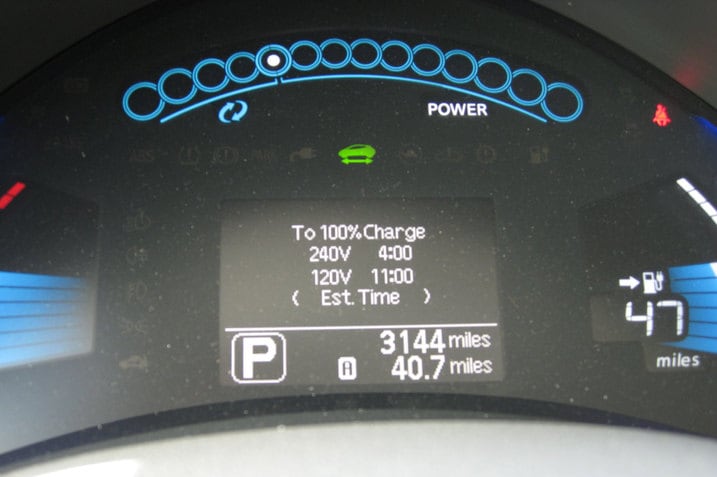
This week is the first time I've driven our 2011 Nissan Leaf home from the office. One direction is 40 miles. I figured this was just too far and the remaining trip range (47 miles) supports my assumption. Now I could probably gamble and make it back without a refresh, but I'd rather not. I need to plug it into the wall. And according to the IP, that will cost me 11 hours. Based on this scenario I could'nt make it through a typical week without a second car.
My commute is probably longer than the average Leaf driver. But if I had a 240V charger at home and the office, the Leaf becomes a feasible mode of transportation for my weekday grind. I didn't expect that.
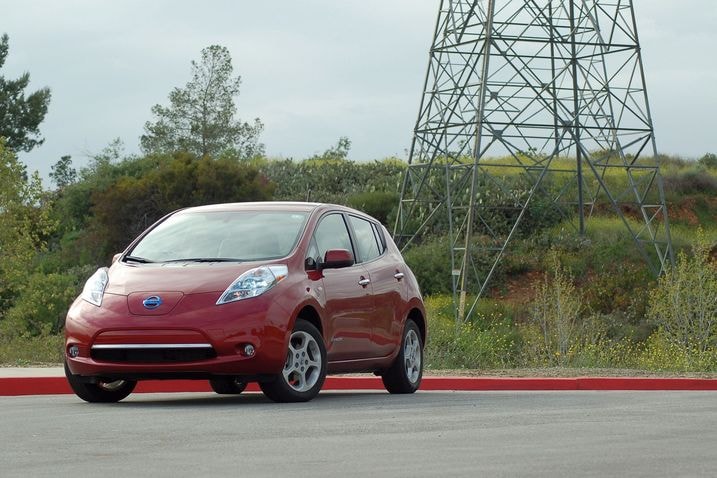
Yes, this time you get two months of fuel consumption data for the price of one. I was busy moving last month and plum forgot to update the electricity and gasoline consumption stats for our 2011 Chevrolet Volt and 2011 Nissan Leaf.
June highlights:
Our Volt went the entire month without gassing up until the bitter end. It could have gone well into July, but we called it in on the last day of June to top it up with 5.42 gallons so I could close out the month and make the calculation. Over some 604 miles, the apparent mpg worked out to 111.5 mpg. Of course only 186.4 of those miles were covered with those 5.42 gallons, so the real gasoline fuel economy was 34.4 mpg. This is possible because we plugged it in a lot in June, as evidenced by a rockin' 69% Utility Factor. These all-electric miles, 417.6 of them, came courtesy of 148 kWh of purchased electricity.
Meanwhile, the Nissan Leaf ran 262.6 miles on 74.9 kWh of juice, and that's pretty much it. Say what you will about the relative merits of these two cars, but the all-electric Leaf is a lot easier to keep tabs on because a constant 100% U.F. is guaranteed.
Now for some nice tables. July Highlights to come after the jump.
| 2011 Chevrolet Volt |
Best |
Worst |
Average |
| Electricity (kwh/100 mi) |
20.6 |
58.4 |
34.0 |
| Electric Range (miles) |
54.6 |
23.5 |
38.4 |
| Gasoline (mpg) |
42.6 |
21.8 |
33.9 |
|
|
|
|
|
| 2011 Nissan Leaf |
Best |
Worst |
Average |
| Electricity (kwh/100 mi) |
22.0 |
53.8 |
33.7 |
| Projected Range (miles) |
104.0 |
65.8 |
85.2 |
| Observed Range (miles) |
76.7 |
|
|
Here are the same charts with the EPA ratings thrown in.
| 2011 Chevrolet Volt |
Best |
Worst |
Average |
EPA |
| Electricity (kWh/100 mi) |
20.6 |
58.4 |
34.0 |
36 |
| Electric Range (miles) |
54.6 |
23.5 |
38.4 |
35 |
| Gasoline (mpg) |
42.6 |
21.8 |
33.9 |
37 |
|
|
|
|
|
|
| 2011 Nissan Leaf |
Best |
Worst |
Average |
EPA |
| Electricity (kWh/100 mi) |
22.0 |
53.8 |
33.7 |
34 |
| Projected Range (miles) |
104.0 |
65.8 |
85.2 |
73 |
| Observed Range (miles) |
76.7 |
|
|
July highlights:
The Volt went on a road trip to Death Valley and Las Vegas, which means it spent much more time on the pump and much less time on the plug. Its Utility Factor dropped accordingly, to just 26%, while the apparent mpg fell to 47.9 mpg. (The real gas-only mpg actually crept up to 35.5 mpg due to the nature of the driving.) As we all know, the more time the Volt spends on gasoline the more the per-mile costs go up. And so it was in this month, as June's 6.2 cents per mile gave way to 9.3 cents per mile in July because of the increased percentage of gasoline miles.
On the other hand the Leaf couldn't even make the trip because, well, it couldn't make the trip. A pure EV isn't going to travel from LA to Vegas unless it's on a trailer. That's probably no big deal for families or couples that have two cars — they'd simply take the other one to Nevada. The payoff for dedicated commuters is a low, low 3.9 cents per mile operating cost, up slightly from last month's 3.2 cents because a couple of leadfooted drivers climbed aboard and because it was a tad warmer, resulting in a bit more use of A/C over the course of the 423.7 miles.
| 2011 Chevrolet Volt |
May |
June |
July |
Overall |
| Utility Factor (% EV miles) |
52% |
69% |
26% |
40% |
| “Apparent” MPG (ignoring electricity) |
76.2 |
111.5 |
47.9 |
56.9 |
| Cost per mile (US average prices) |
7.0¢ |
6.2¢ |
9.3¢ |
8.4¢ |
| (Cal. average prices) |
7.8¢ |
7.2¢ |
9.7¢ |
9.2¢ |
| (at my house) |
10.2¢ |
11.2¢ |
11.2¢ |
11.4¢ |
|
|
|
|
|
|
| 2011 Nissan Leaf |
May |
June |
July |
Overall |
| Utility Factor (% EV miles) |
100% |
|||
| “Apparent” MPG (ignoring electricity) |
Infinity (zero gas used) |
|||
| Cost per mile (US average prices) |
3.8¢ |
3.2¢ |
3.9¢ |
3.5¢ |
| (Cal. average prices) |
5.0 ¢ |
4.2¢ |
5.1 ¢ |
4.7¢ |
| (at my house) |
10.5¢ |
8.8¢ |
10.7¢ |
9.8¢ |
|
|
|
|
|
|
| Popular hybrids, for reference |
May |
June |
July |
Overall |
| 2011 Toyota Prius (US average prices) |
7.5¢ |
7.1¢ |
7.4¢ |
7.2¢ |
| (Cal. avg prices) |
8.0¢ |
7.6¢ |
7.6¢ |
7.7¢ |
| 2011 Ford Fusion Hybrid (US avg prices) |
9.7¢ |
9.1¢ |
9.5¢ |
9.2¢ |
| (Cal. avg prices) |
10.2¢ |
9.7¢ |
9.8¢ |
9.9¢ |
That is all.
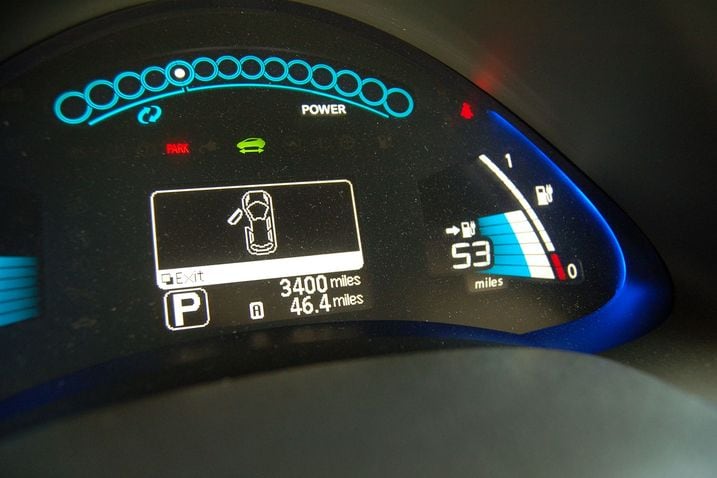
The dash predicted 99 miles of total range when I left work in the 2011 Nissan Leaf this afternoon. Things look much the same now that I'm home, and it seems like I have enough remaining range to risk NOT plugging in an attempt to make the return trip on the same charge.
Should I go for it?
Before you answer, consider this:
- In normal usage, no one in the office has driven this machine more than 76.7 miles on a single charge before wussing out — and that was me. If I am able to make it back I will smash that record with something like a 92.8-mile run.
- The Leaf's official EPA range rating is 75 miles, but that's on a combined basis; it's not a maximum.
- We have run out of juice in this machine before, and it wasn't any fun. The range meter doesn't seem to have any sort of pessimistic safety margin built in, either.
- I do have a AAA account in good standing.
- My trip home today included the perfect amount of traffic — I was never able to go over 60 mph and I spent a lot of time going with the slightly retarded flow at 35-45 mph.
- I'll have little or no traffic tomorrow morning unless I leave later than usual in an attempt to catch a little, or I can choose to run with the trucks in the right lane to keep my speed in check.
- I will not need headlights or air conditioning tomorrow morning.
I fretted over the same scenario in our departed Mini E once upon a time, and in that instance I made it back with miles to spare.
On the one hand I'm curious. The competitive part of me wants to put the office range record safely out of reach. On the other hand I just want to get on with my morning.
I have until bedtime to decide.
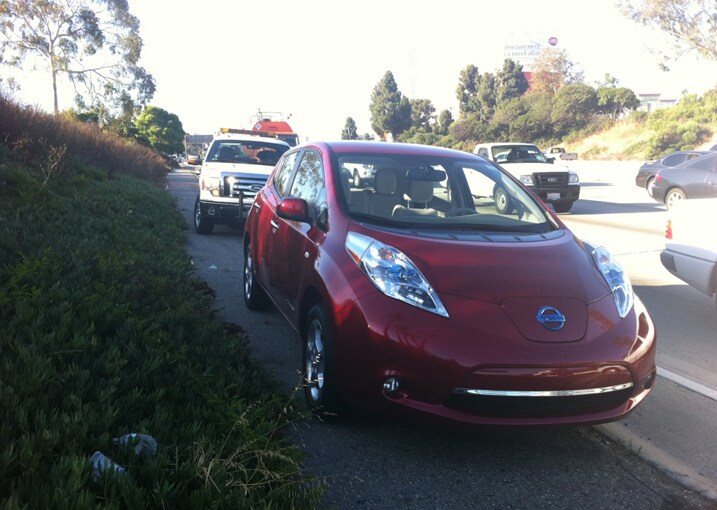
Anyone else here following Dan Edmunds on Twitter? If you are you'd know that he intended to try a round-trip commute from office to home (46 miles) to office (another 46 miles) on one charge.
He didn't make it (I'll let him explain why in another post — his math was right but there were, as happens in real life, some unforeseen occurrences which he's tweeted) and is currently waiting for a tow on the 405. "I should have made it with no problem. I had a 7 mile surplus and I never drove faster than 53." reads a text he sent me seconds ago.
**The tow truck driver just drove past him. And with no turtle showing, he's going to risk the 5 mile drive to our photo studio**
** He's made it to the studio — not our office — thanks to a sub-freeway speed and ample use of four-way flashers**

Our 2011 Nissan Leaf is safely tucked away in the Edmunds, garage, but try as I might I was unable to make the 93.2-mile round trip on a single charge. After a series of unexpected events I had to stop short of my goal and duck into the Edmunds static test lab/photo studio for 90 minutes to add in enough juice to get me through the last 3.5 miles.
It started last night, when I completed my 46.6-mile commute home with 53 miles of additional range left on the meter. Getting back to work the next day on a single charge had seemed so easy, so possible, especially since I had done it previously over a longer distance in a less-sophisticated Mini E.
And then there was our experience running the Leaf on a closed course for 132 miles, in which the predictive powers of the range gauge had been spot-on. A 6.5-mile cushion seemed like more than enough to make it back this morning.
And it might have been, too, if only I hadn't gotten a little too eager/desperate to enter the carpool lane when the 405 freeway started to bunch up around Century Blvd.
Even though our Leaf has access stickers, I had been avoiding the carpool lane because it was moving too fast. Making it to work demanded that I keep my speed down in the 40s and 50s, just as traffic had done to the Leaf naturally last night. So I kept to the right lane, running with the trucks and the battered Toyota Hilux pickups full of lawnmowers.
Things were looking OK, and then traffic built to the point where the carpool lane was going slow enough for my purposes but faster than everyone else. I hopped in. Later on, when the carpool lane opened up, I got back into the regular lanes to soak in traffic and proceed at 30 or 40 mph with everyone else for awhile.
And so it went.
With the end in sight the 405 started to pack up solidly as I passed under the flight path at LAX. I started to ease back over to enter the carpool lane — the entrance about a half mile ahead. I was getting nervous at this point, because my 6.5-mile surplus had shrunk to just under 2 miles. Only 11 miles showed on the range meter with 9 and-a-bit miles to go and I was anxious to keep moving at 25 mph — the exact speed the carpool lane was now going.
With 200 yards to go I got impatient in the throes of a fully developed case of range anxiety. I could see the entrance signs, see cars ahead moving in, so I rationalized and did something I have never ever done: I entered the carpool lane a little ways before the official entrance point. It was safe, the Leaf had valid permission stickers, no one was barrelling up from behind (in fact someone three or four cars back did the same thing in a classic pick move), but none of that mattered to the CHP officer sitting about 10 cars ahead of me, obscured from my view by a truck until it was too late.
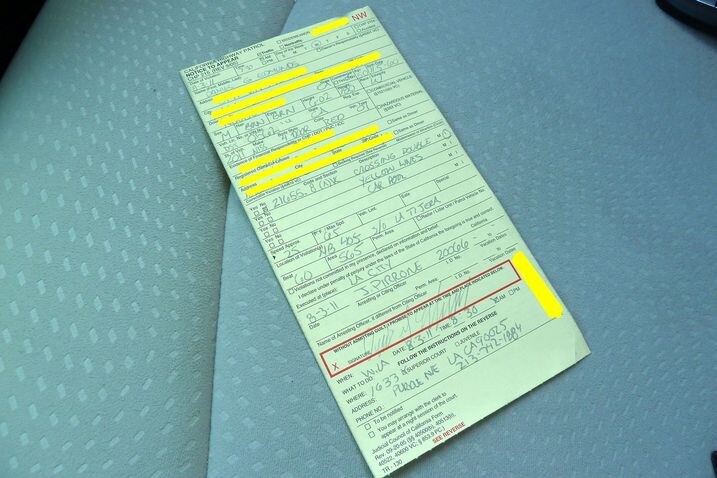
Dumb, dumb, dumb, dumb, dumb, dumb, dumb. The thing that sucks most is my local freeways, the 91 and 55 in Orange County, have recently introduced open access carpool lane controls, allowing motorists to enter and exit at any point. I would not have received this ticket 20 miles back down the road.
Incidentally, I've never seen any carpool lane pileups on those OC freeways, either. Quite the opposite, in fact, as drivers on my home turf no longer have to bunch up and make dubious lane changes in front of unsympathetic motorists in an attempt to get in or out of the small (and artificial) entry and exit ports they are forced to wait for in LA. In the land of Carmageddon traffic stacks up as concentrations of cars attempt to criss-cross in and out at the few designated choke points.
Instead the officer quoted the standard line that says getting in or out at points other than the designated points is "dangerous". The carpool lane policies in Northern California and on the 55 and 91 freeways suggest that this matter is currently up for debate within our state, but the fact remains that range anexiety got the better of me and I jumped about 150 or 200 yards too soon in a place where, for the time being, at least, they frown on that sort of thing.
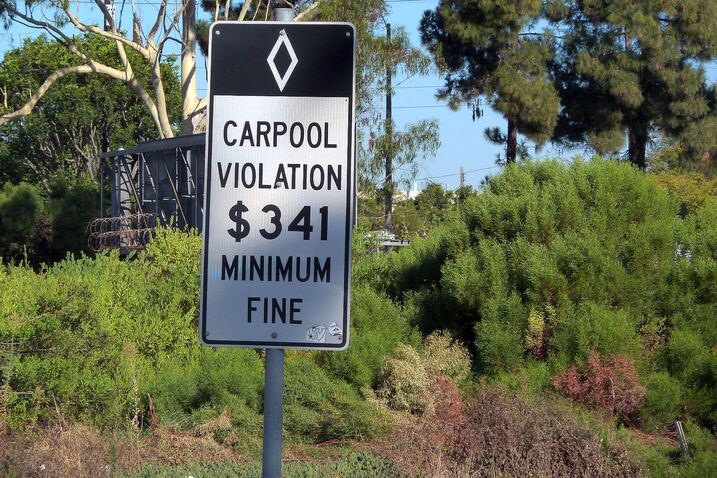
And so, dear readers, I did not simply crap out on the side of the freeway, putting myself and others at risk in a stupid attempt to prove something about electric cars by, ironically, driving more conservatively than everyone else on the road. No, I got pulled over and was directed to the side of the road by a CHiP in a Crown Vic.
In the process of getting pulled over, the range meter dropped down to "---", meaning I no longer had any way to judge my remaining range or what this incident had cost me. I decided to punt. I asked the officer if he could also please summon a AAA tow truck.
He was a bit perplexed as I explained that I was in an electric car and had been attempting to keep moving in order to make it to my destination before I ... ended up on the side of the road like we were now. I showed him the range indication's "---" display and he saw the nav screen's Very Low Battery warning. Gazing back up at the stop-and go traffic inching past us, he understood. Nevertheless, he told me he could not unwrite the ticket at this point. He might have felt bad about it, but I don't really know what that emotion looks like on a patrol officer.
He called AAA for me, apologized for the inconvenience and waded back out into traffic as I sat there and waited for the flatbed.
About 20 minutes later my tow truck passed by without stopping, apparently looking for some OTHER red Nissan Leaf on the side of the freeway.
At this point I was simmering. And then it dawned on me that our new static lab was a couple miles closer to my position than the office. Duh. A quick check of Google maps put it 5.8 miles away. I decided to go for it, figuring I wouldn't be any worse off than I was already. Traffic was moving along at a nice steady 25 mph at this point, so conditions looked perfect for clandestine hypermiling. As a bonus, the route to the lab included a couple miles on the deserted 90 freeway, meaning I'd be well out of harm's way with a couple of handy exits to bail out on if this didn't work.
In short, it did work, and the empty lanes of the 90 allowed me to proceed at a slow pace with the 4-ways on until I got to the final mile of surface streets.
With 89.9 miles on the clock I rolled in to the lab and plugged in for about 90 minutes to ensure I'd have enough to make the 3.5 mile final leg to the office.
Lessons learned:
You'd think an electric car's range meter would be hyper-accurate, but don't get sucked in. It was quite accurate in our closed course test at a steady 30 mph, but that was because of the steady 30 mph part. Despite by best efforts to duplicate yesterday's driving pattern, my 6.5-mile cushion evaporated quicker in the real world than I could ever have guessed.
46 miles away is too far away from work for a Leaf if, like most everyone, you can only plug in at one end of your commute. Based on this and other experiences I'd recommend no more than 35 miles, a 70-mile round trip, in order to keep a decent safety margin. Even at that distance it's best to stay out of the fast lane. 30 miles is probably a better maximum commute radius if you want to drive like a normal person.
Carpool lanes aren't really that great for electric cars — my problem notwithstanding — because going fast in an open lane does your range no favors. Carpool lanes work best for this car when traffic is impacted and the carpool lane is moving slower than the posted limit but faster than everyone else.
Finally, even though you may have sat idly by and watched hundreds get away with something for years and years that you're too afraid to try, don't think that you'll be able to get away with it "just this once". Chances are one Mr. Murphy will be waiting to smack you upside the wallet with one of his infamous laws. Ouch.

This is not a picture of our Long Term 2011 Nissan Leaf. This is my own Leaf, or at least my own for the next three years of the lease. I reserved my Leaf last year thinking I might turn it down when it arrived. Since then, I've gone back on forth on my pending decision. Driving our long termer convinced me it was a comfortable and capable car, despite Dan Edmunds' recent range adventure. But it is another thing altogether to plunk down $2,000 and begin monthly payments of $440. How practical of a commuter car would it really be? Could I really expect to log 12,000 miles a year behind the wheel?
Gaining access to the car pool lanes was strong motivation. But I've always been curious about electric cars and once even considered converting a gas car to electric (YouTube is filled with such home-grown projects). So I finally decided to take the plunge and sign on the dotted line. Paul Scott, an EV proponent turned EV salesman, handled the delivery process today at Santa Monica Nissan and went over every inch of the car and every menu of the computer interface. He recommended driving it in Eco mode most of the time and switching to the normal drive only when a BMW pulls up next to you at a stop light.
I still feel that this doesn't signal a complete conversion to electric power. It is a three-year experiment that might leave me hankering for the smell of gas. But at least for now, I'm pretty psyched about my new car and looking forward to getting to know it better.
Stay tuned.
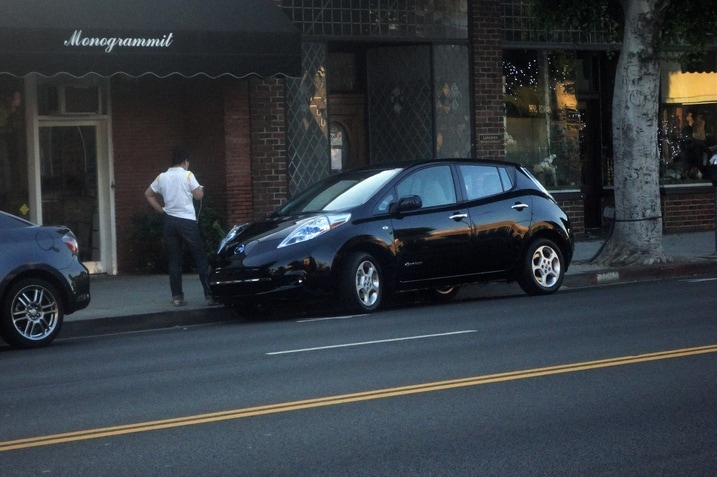
Spotted this Nissan Leaf on Robertson Boulevard the other day. Prior to this one, I think I've only ever seen one other Leaf on the road — they're not a common sight here in Los Angeles.

To my eyes, the Leaf looks less awkward in black, relative to our red model. What do you think — should Phil have gotten his in black instead of red?
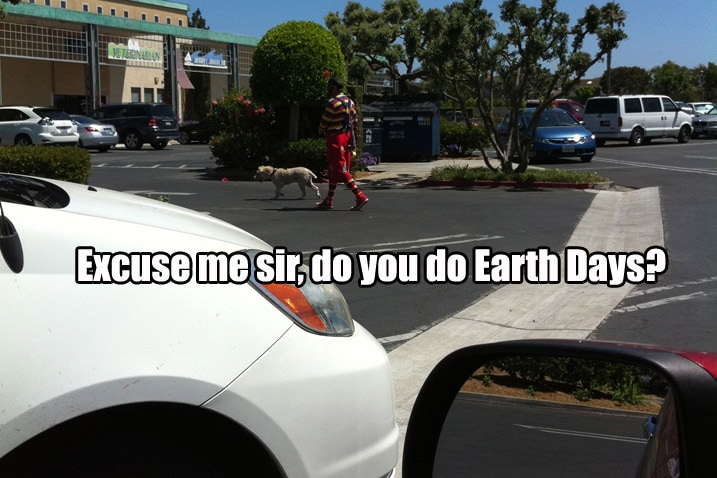
Thanks to aleclance for this week's favorite caption. Here are the others that make us honk.
The Surreal Leaf. (rotaryboff)
Let's make like a tree and ... get the heck out of here. (ms3omglol)
Sad clown: out of charge. (rotaryboff)
Nissan Leaf: Alternative Fool Vehicle (ergsum)
Cirque du SoLeaf (kain77)
Nissan Leaf: Good for around clown driving. (ergsum)
Objects in mirror are creepier than they appear (ergsum)
Our footprint is small even if yours aren't (aleclance)
The Nissan Leaf: A clowning achievement! (bmwm1)
A clown takes his dog for a little Shift_ (teampenske3)
And all of a sudden, the anti-shtick brakes engaged. (ergsum)
So a dog, a clown, and a Leaf walk into this bar . . . (pete5o5)
The other two dozen are still inside the car. (bradyholt)
Bumper sticker reads: "My other vehicle is a Unicycle" (ergsum)
Leaf hits clown: arrested for a battery (noburgers)
Will the clown fit? (technetium99)
Fridays comic re-Leaf. (technetium99)
106 mpg/city, 92 mpg/around clown (mikeschmidt)
What was your favorite?
To the winner:
You can select one of these three prizes.

- Top Gear Season 14 (Blu-ray only)
- MOPAR t-shirt (size M or L)
- Imported From Detroit t-shirt (size L)

I know you can barely see the Nissan Leaf in this picture, just a bit of mirror. But how do you pass up a clown photo?
What is your caption?
We'll post our favorite this afternoon.

Our long-term 2011 Nissan Leaf has a photovoltaic solar panel embedded in the rear spoiler that's part of the higher-level SL trim package.
Although it doesn't charge the vehicle's lithium ion batteries used for propulsion, the solar panel does help to charge the 12V accessory battery.
Hey, it's something! And it's a good start towards further solar energy progress.
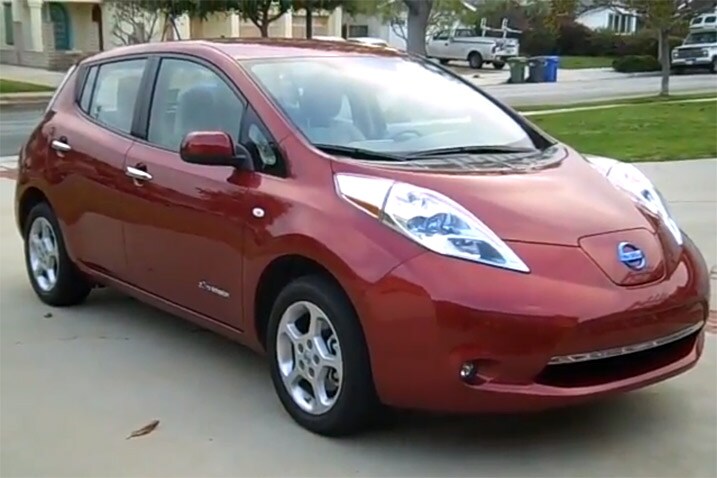
Here is a video walkaround of our Nissan Leaf and it starting up. The Leaf will be leaving the fleet soon as it was only a six-month loan. I'll miss it.
Click through for two and a half minutes of Leafiness.

Many of us that work here get hit up all the time about vehicle recommendations.
My buddy Bob, who lives in the San Francisco Bay Area and is successful in the software business, rang me up a few weeks ago.
"I'm thinking of getting a Tesla Roadster," he tells me. "How much is that?" I ask. He said he could get a used one for $60 or $70K.
Edmunds.com has the MSRP of a new 2011 Tesla Roadster 2.5 Sport pegged at $128,500, to start. Wow.
I ask: why don't you get a Nissan GT-R or a Porsche or something instead?
"That won't get me in the car pool lane," he says. Oh, so that's what this is about.
He said we wants to get in that car pool lane, but also wants something that's going to be fun and that he can track occasionally.
OK, how about getting a Nissan Leaf AND a Nissan GT-R or a Mustang Boss 302, I ask him. You can get both the Leaf, which is an excellent EV commuter car, and another fun weekend/track car for the price of that Tesla.
Well, that got his attention.
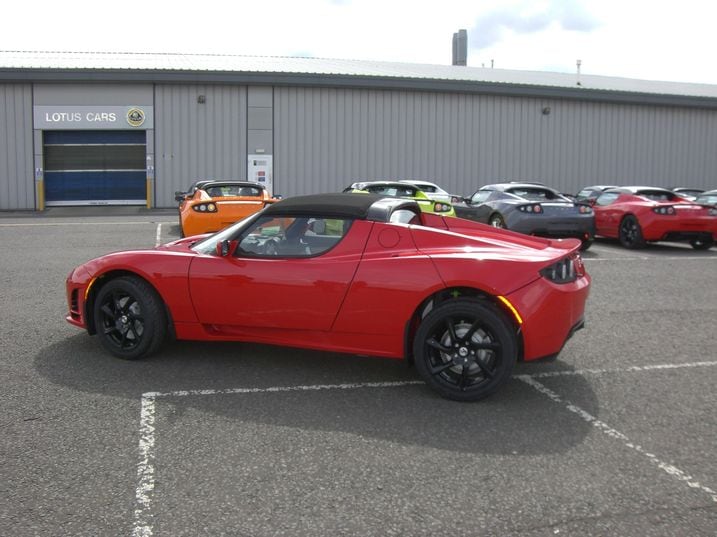
He told me that what I recommended made some sense and that he would mull it over.
But guess what? He ended up getting the Tesla anyway. And a new one at that.
He's happy with it, even sending me pics that Tesla took of his vehicle on the production line before he received it.
Although many of us (including you, our readers) get consulted on vehicle purchases, many times the person asking is simply seeking affirmation of the already-intended vehicle.
The moral of this story: buy what you want.
That's what Bob did.
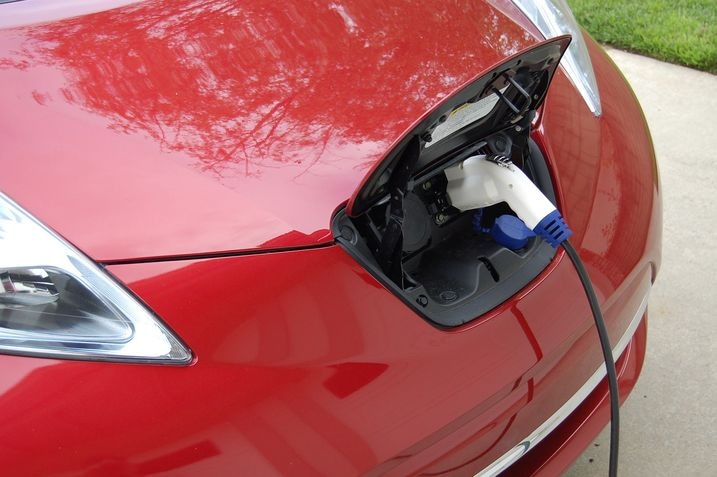
It's not news that in this age of Twitter, Facebook, blogs and forums, people are telling each other off online instead of in person. But when one 2011 Nissan Leaf owner chose to vent on a Nissan Leaf forum after another electric car owner wronged him at a charging station in Los Angeles International Airport, well it's just a good read.
Basically the Leaf owner left his car at the station to be charged for a few hours but when he returned he saw that another electric car owner unplugged his car and plugged his/her own. So rude! He then complained to a Leaf forum where its members hunted down the other driver and are now keeping watch on that other car which, after two weeks, STILL hasn't moved.
In any case, I can't believe the gall of that person and wonder if this is a common occurrence at charging stations with people unplugging each other. Can't say I'm surprised as environmentally-conscious folks have been accused of treating the environment better than they treat people.
Electric car owners, has anything like this ever happened to you?
Wrap-Up
A series of Twitter posts involving our 2011 Nissan Leaf summarized the risk, reward and range anxiety posed by driving the EV on a daily basis. The following string of entries was courtesy of Director of Vehicle Testing Dan Edmunds:
Aug 1 — (16:00) Time to take advantage of our Leaf's new carpool lane stickers.
Aug 2 — (17:30) At home with our Nissan Leaf after commuting 46.4 miles. Range meter says I have 53 miles for the return trip.
Aug 3 — (07:30) My Nissan Leaf round-trip test failed with a ticket for entering the carpool lane a couple hundred yards too soon in an attempt to make it.
Aug 3 — (07:50) Waiting for my tow but the AAA flatbed just passed me and kept going #%^$&.
Aug 3 — (08:00) Tired of waiting for a tow. Decided to inch the Nissan Leaf forward off the freeway. At a nearby shop.
Aug 3 — (8:30) Today I thought I would do something cool and interesting in the name of science and it totally blew up in my face.
Why We Bought It
Is an electric vehicle the solution? We posed this question at the introduction of our long-term test of the 2011 Nissan Leaf. After six months with an electric vehicle as our primary mode of transportation, we hoped to know the answer.
This was the first year of production for the Leaf. It was powered by a lithium-ion battery pack generating 107 horsepower and 207 pound-feet of torque. EPA estimates gave it a range of just over 70 miles, which fit our commutes nicely. Before the Leaf, public exposure to electric cars was limited to low-volume test cases. This Nissan was a true EV built for mainstream consumption for under $35,000. We were intrigued.
The only way to test the practicality of an electric vehicle was to drive one every day. With that objective in mind, our long-term test began.
Life on Electricity
Battery life is a constant concern with electric vehicles. The Leaf was no exception. To own an EV requires planning and the realization that this car can't do it alone. A second form of transportation is a necessity. Associate Editor Mark Takahashi wrote, "The Leaf probably isn't the best car in an emergency.... You need something reliable with a decent amount of range. In seismically active Southern California, the Leaf would be one of the worst choices when the Big One hits. Power would likely be out for weeks, so charging is out. That means getting around just got more complicated."
We found battery charging was also an obstacle to owning an EV. One editor noted, "This is the first time I've driven our Leaf home from the office. After 40 miles in one direction the DTE (distance to empty) reads 47 miles. Now I could gamble and make it back without a refresh, but I'd rather not. I need to plug it into the wall. According to the IP, it will cost me 11 hours to charge the Nissan from my 120-volt outlet. At 240 volts it shortens to 4 hours. My commute is probably longer than that of the average Leaf owner. But based on my situation I could not make it through a typical work week without another car."
Reliance upon the distance-to-empty meter did leave us stranded on two occasions. One such event, cited above, was documented by Dan Edmunds and the California Highway Patrol. A second run-in with roadside assistance occurred 1.5 miles from our office with Automotive Content Editor Warren Clarke behind the wheel. Clarke blogged, "I don't have a lot of driving planned and figure the quiet weekend will be a good match for the Leaf's limited range. The weekend winds up being more social than I'd anticipated. By the time Monday morning yawns and stretches, the DTE gauge is showing 13 miles. No cause for concern, I reason. I live only 7 miles from the Edmunds nerve center, so I decide to go for it. A couple moments later, I see it — the flashing tortoise. After a block or so, the Leaf checks out. I'm a block from a major intersection. No nearby spots to push the car. Nothing left to do but call AAA and wait."
As far as reliability went, our limited six-month test equated to a spotless problem history. A tire rotation and cabin air filter change isn't even a consideration until 7,500 miles. Severe service intervals don't call for brake and battery inspections until 15,000 miles. We experienced no mechanical issues during our test.
Total Body Repair Costs: None
Total Routine Maintenance Costs (over 6 months): None
Additional Maintenance Costs: None
Warranty Repairs: None
Non-Warranty Repairs: None
Scheduled Dealer Visits: None
Unscheduled Dealer Visits: None
Days Out of Service: None
Breakdowns Stranding Driver: None
Performance and Fuel Economy
We didn't expect outstanding instrumented test results from the 2011 Nissan Leaf. Our 3,300-pound EV accelerated from zero to 60 mph in 9.9 seconds (with rollout) and completed the quarter-mile in a leisurely 17.5 seconds at 75.9 mph. From 60 mph the Leaf reached a stop in 130 feet. It passed through the slalom at 60.3 mph and generated 0.78g of lateral force around the skid pad. The most limiting factor in these performance categories was its Bridgestone Ecopia EP422 tires, built for low rolling resistance rather than adhesion.
This test was about fuel economy above all else. Was electricity a viable alternative to gasoline? One of the most important factors to consider was range. Nissan's original claim for the Leaf was 100 miles. Under certain driving conditions this figure could vary from 62 to 138 miles. The EPA rated it at 73 miles. After 3,500 miles our Leaf performed better than both estimates, averaging a projected range of 86 miles. But we found the variability of real-world driving made the DTE meter somewhat unreliable. During one closed-course test we set the cruise to 35 mph and drove our fully charged Leaf until it would go no more. We covered a total of 132 miles and consumed electricity at a rate of 19.8 kilowatt hours per 100 miles (kWh/100). Then we towed it home.
Cost per mile was another element of Leaf ownership to consider. We used the cost of electricity on both a California and national level for measurement. Over 3,500 miles our Leaf cost us 4.7 cents/mile to operate in California. Based on the national average it was a bit less, 3.5 cents/mile. Now consider a 50-mpg Toyota Prius. Here, we also used both the California and national averages for gasoline prices. Over the same time period, the hybrid would cost 8 cents/mile to own in California and 7.5 cents/mile nationwide.
Best Fuel Economy: 22.0 kWh/100
Worst Fuel Economy: 53.8 kWh/100
Average Fuel Economy: 33.4 kWh/100
Best Observed Range: 89.9 miles
Best Projected Range: 104.0 miles
Worst Projected Range: 65.8 miles
Average Projected Range: 85.5 miles
Retained Value
At the time of our test, resale value information on the 2011 Nissan Leaf was unavailable. These cars were only six months old. Owners weren't selling them yet. Some dealerships hadn't even received their first sellable units.
True Market Value® at service end: Unavailable
Depreciation: Unavailable
Final Odometer Reading: 3,551
Summing Up
We lived with a 2011 Nissan Leaf for six months. Over this time we drove it for 3,500 miles and towed it another 900 miles. To be clear, most of the flatbed miles were the result of special tests and the distant locations we traveled to perform them. We called roadside assistance for rescue just twice. No mechanical failures. We simply ran out of juice too far from home. We don't hold the Nissan responsible for stranding us, but these events shed light on the pitfalls of an EV as a primary commuter car. Three elements must be considered when discussing the Leaf: range, charge and cost.
Range was the most important aspect of Leaf ownership. We wished the DTE meter was more trustworthy. Despite averaging a projected 86 miles per charge, to drive much farther than 70 miles between charges was a risk. Real-world driving situations were too unpredictable.
Battery charging was also a concern. A dedicated 240-volt charger would fully replenish the Leaf in about 4 hours, regardless of the mileage driven. On the other hand, a 120-volt outlet needed upward of 11 hours to restore the battery to full after just 40 miles of driving. The lack of 240-volt chargers on both ends of our commute required careful time management lest we chance being stranded.
Cost was one clear advantage of the Leaf over gasoline-powered automobiles. The Nissan cost over 3 cents less per mile to operate than a 50-mpg hybrid. Local driving situations give it a leg up on its gasoline competitors. But our infrastructure cannot support long-distance all-electric travel. The same, more expensive gasoline-hybrid can traverse the country, while the Leaf will never leave the city. Is 3 cents per mile worth the loss of versatility? Only if you have a second gasoline-powered car to fall back on.
The manufacturer provided Edmunds this vehicle for the purposes of evaluation.
